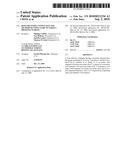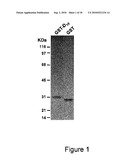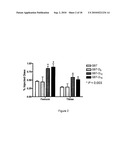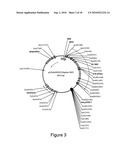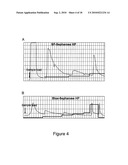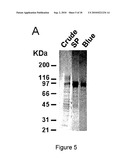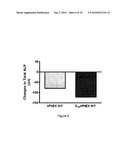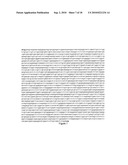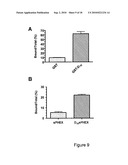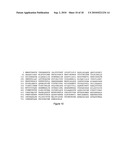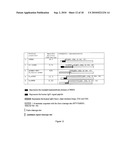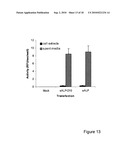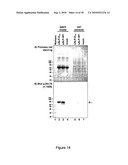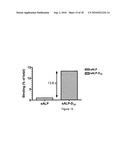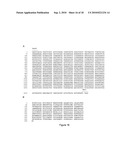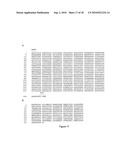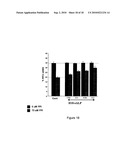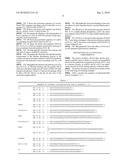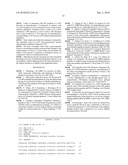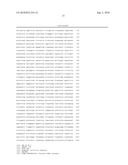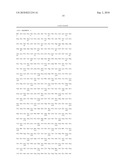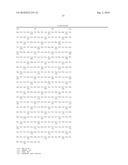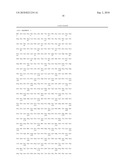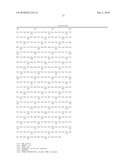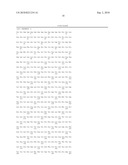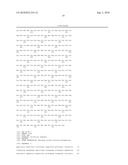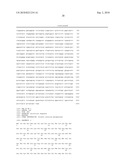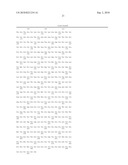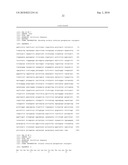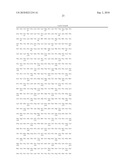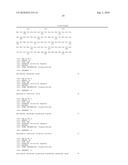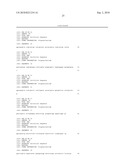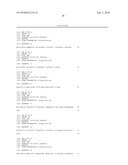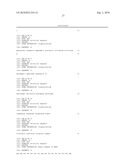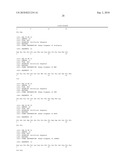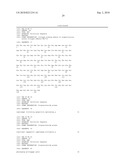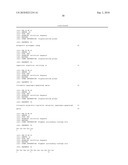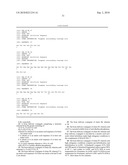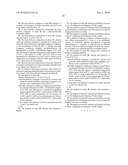Patent application title: BONE DELIVERY CONJUGATES AND METHOD OF USING SAME TO TARGET PROTEINS TO BONE
Inventors:
Philippe Crine (Outremont, CA)
Guy Boileau (Brossard, CA)
Isabelle Lemire (Montreal, CA)
Thomas P. Loisel (Montreal, CA)
Assignees:
Enobia Pharma Inc.
IPC8 Class: AA61K3846FI
USPC Class:
424 943
Class name: Drug, bio-affecting and body treating compositions enzyme or coenzyme containing stabilized enzymes or enzymes complexed with nonenzyme (e.g., liposomes, etc.)
Publication date: 2010-09-02
Patent application number: 20100221234
Claims:
1-11. (canceled)
12. A bone delivery conjugate comprising a structure selected from the group consisting of:A) X-Dn-Y-sALP-Z; andB) Z-sALP-Y-Dn-X,wherein X is absent or is an amino acid sequence of at least one amino acid;Y is absent or is an amino acid sequence of at least one amino acid;Z is absent or is an amino acid sequence of at least one amino acid;Dn is a poly aspartate wherein n=10 to 16; andsaid sALP is a soluble alkaline phosphatase.
13. The bone delivery conjugate of claim 12, wherein said structure is: Z-sALP-Y-Dn-X.
14. The bone delivery conjugate of claim 13, wherein Y is an amino acid sequence of at least one amino acid and X and Z are absent.
15. The bone delivery conjugate of claim 14, wherein n=10.
16. The bone delivery conjugate of claim 13, wherein said sALP is a secreted soluble form of said alkaline phosphatase.
17. The bone delivery conjugate of claim 13, wherein said bone delivery conjugate is encoded by a nucleic acid molecule which hybridizes under high stringency conditions to the complement of SEQ ID NO: 7.
18. The bone delivery conjugate of claim 17, wherein said high stringency conditions comprise pre-hybridization and hybridization in 6.times.SSC, 5.times.Denhardt's reagent, 0.5% SDS and 100 mg/ml of denatured fragmented salmon sperm DNA at 68.degree. C.; and washes in 2.times.SSC and 0.5% SDS at room temperature for 10 minutes; in 2.times.SSC and 0.1% SDS at room temperature for 10 minutes; and in 0.1.times.SSC and 0.5% SDS at 65.degree. C. three times for five minutes.
19. The bone delivery conjugate of claim 18, wherein Y is an amino acid sequence of at least one amino acid and X and Z are absent, and wherein n=10.
20. A bone delivery composition comprising the bone delivery conjugate of claim 12 and a pharmaceutically acceptable carrier.
21. The bone delivery composition of claim 20, wherein said structure is: Z-sALP-Y-Dn-X.
22. The bone delivery composition of claim 21, wherein said bone delivery conjugate is encoded by a nucleic acid molecule which hybridizes under high stringency conditions to the complement of SEQ ID NO: 7, wherein said high stringency conditions comprise pre-hybridization and hybridization in 6.times.SSC, 5.times.Denhardt's reagent, 0.5% SDS and 100 mg/ml of denatured fragmented salmon sperm DNA at 68.degree. C.; and washes in 2.times.SSC and 0.5% SDS at room temperature for 10 minutes; in 2.times.SSC and 0.1% SDS at room temperature for 10 minutes; and in 0.1.times.SSC and 0.5% SDS at 65.degree. C. three times for five minutes.
23. The bone delivery composition of claim 22, wherein Y is an amino acid sequence of at least one amino acid and X and Z are absent, and wherein n=10.
24. A method of delivering a protein to bone tissue of a mammal comprising administering to said mammal an effective amount of the bone delivery conjugate of claim 12.
25. The method of claim 24,wherein said structure is: Z-sALP-Y-Dn-X;said bone delivery conjugate is encoded by a nucleic acid molecule which hybridizes under high stringency conditions to the complement of SEQ ID NO: 7;said high stringency conditions comprise pre-hybridization and hybridization in 6.times.SSC, 5.times.Denhardt's reagent, 0.5% SDS and 100 mg/ml of denatured fragmented salmon sperm DNA at 68.degree. C.; and washes in 2.times.SSC and 0.5% SDS at room temperature for 10 minutes; in 2.times.SSC and 0.1% SDS at room temperature for 10 minutes; and in 0.1.times.SSC and 0.5% SDS at 65.degree. C. three times for five minutes;Y is an amino acid sequence of at least one amino acid and X and Z are absent; andn=10.
26. The method of claim 24, wherein said mammal is human.
27. The method of claim 26, wherein said effective amount is 1 to 10 milligrams per kilogram of body weight.
28. The method of claim 27, wherein said effective amount is administered to said human more than once at an interval ranging from daily to weekly.
29. The method of claim 26, wherein said effective amount is about 1 milligram per kilogram of body weight.
30. A method of treating a condition or disease related to a bone defect characterized by a lack of or an insufficient amount of functional alkaline phosphatase comprising administering to a mammal in need thereof an effective amount of the bone delivery conjugate of claim 12, wherein the conjugate is in a pharmaceutically acceptable carrier.
31. The method of claim 30, wherein said condition or disease is hypophosphatasia.
32. The method of claim 30, wherein said structure is: Z-sALP-Y-Dn-X;said bone delivery conjugate is encoded by a nucleic acid molecule which hybridizes under high stringency conditions to the complement of SEQ ID NO: 7;said high stringency conditions comprise pre-hybridization and hybridization in 6.times.SSC, 5.times.Denhardt's reagent, 0.5% SDS and 100 mg/ml of denatured fragmented salmon sperm DNA at 68.degree. C.; and washes in 2.times.SSC and 0.5% SDS at room temperature for 10 minutes; in 2.times.SSC and 0.1% SDS at room temperature for 10 minutes; and in 0.1.times.SSC and 0.5% SDS at 65.degree. C. three times for five minutes;Y is an amino acid sequence of at least one amino acid and X and Z are absent; andn=10.
33. The method of claim 30, wherein said mammal is human.
34. The method of claim 33, wherein said effective amount is 1 to 10 milligrams per kilogram of body weight.
35. The method of claim 34, wherein said effective amount is administered to said human more than once at an interval ranging from daily to weekly.
36. The method of claim 33, wherein said effective amount is about 1 milligram per kilogram of body weight.
Description:
CROSS REFERENCE TO RELATED APPLICATIONS
[0001]This application is a continuation of U.S. application Ser. No. 11/111,664, filed Apr. 21, 2005, which claims the benefit of the filing dates of U.S. Provisional Application Nos. 60/563,828 filed Apr. 21, 2004, 60/590,347 filed Jul. 23, 2004, and 60/614,984 filed Oct. 4, 2004, each of which is incorporated herein by reference.
FIELD OF THE INVENTION
[0002]The present invention relates to bone delivery conjugates and method of using same to target proteins to bone. More specifically, the present invention relates to bone delivery compositions comprising peptide motifs, engineered within the structure of a protein through recombinant DNA technology to promote binding to bone matrix.
BACKGROUND OF THE INVENTION
[0003]Technological advances in molecular biology, recombinant protein production and large scale protein purification have allowed the production of large amounts of proteins now used as biopharmaceuticals. For example, monoclonal antibodies and soluble forms of the TNF-a receptor have been used in the treatment of autoimmune diseases such as Crohn's disease or severe forms of psoriasis (1). Another example of use of recombinant protein is enzyme replacement therapy (ERT). ERT has been used to treat lysosomal storage diseases. This group of genetic disorders is characterized by the loss of function of lysosome enzymes resulting in severe somatic, and sometimes neuronal, pathologies. In ERT for these diseases, the patients are infused with large doses of normal enzymes. These infused enzymes are then internalized from circulation via cell surface receptors (mannose-6 phosphate receptor) and enter the endocytic pathway on their way to their site of action, the lysosome. Not all attempts to treat genetic disorders through ERT have been successful.
[0004]Hypophosphatasia is a rare, heritable type of rickets or osteomalacia that occurs with an incidence of 1 per 100,000 births for the more severe form of the disease. Milder forms are more prevalent. In this inborn metabolism defect, mutations inactivate the gene that encodes the tissue-nonspecific isoenzyme of alkaline phosphatase. It is characterized biochemically by subnormal alkaline phosphatase activity in serum. Alkaline phosphatase deficiency in osteoblasts and chondrocytes impairs skeletal mineralization, leading to rickets or osteomalacia.
[0005]There is a very broad range of expressivity of hypophosphatasia, spanning from a perinatal form often causing stillbirth from an unmineralized skeleton, to a milder form featuring only premature loss of teeth. Severely affected infants and children inherit hypophosphatasia as an autosomal recessive trait. There are four main forms of the disease: perinatal, infantile, childhood and adult. Perinatal hypophosphatasia manifests during gestation and most affected newborns survive only briefly. Infantile hypophosphatasia becomes clinically apparent before 6 months of age. About 50% of patients die within a year. Childhood hypophosphatasia varies greatly in severity but most of these patients will suffer from skeletal symptoms throughout their life. Adult hypophosphatasia appears during middle age, with symptoms such as painful recurrent stress fractures having poor healing.
[0006]Osteoblasts and chondrocytes are normally rich in tissue-nonspecific alkaline phosphatase where it is attached to the cell surface. In hypophosphatasia, the lack of alkaline phosphatase activity results in the extracellular accumulation of three phosphorus-compounds believed to be substrates of the enzyme: phosphoethanolamine (PEA), inorganic pyrophosphate (PPi) and pyridoxal 5'-phosphate (PLP). PPi is an inhibitor of hydroxyapatite crystal growth, and PPi build-up in the disease accounts for the impaired skeletal mineralization. Consequently, providing active enzyme to patients suffering from hypophosphatasia will decrease extracellular PPi levels and improve skeletal mineralization.
[0007]Currently, there is no established medical therapy for hypophosphatasia. Trials of enzyme replacement using intravenous infusions of alkaline phosphatase have failed. It appears that alkaline phosphatase activity must be increased not in circulation but in the skeleton itself. This hypothesis was confirmed recently by bone marrow transplantation. Unfortunately, the benefits of the transplantation lasted only for a short period of time due to poor engraftment.
[0008]There is a therefore a need to provide enzyme replacement therapy approach to provide active enzyme to the skeleton of patients suffering from hypophosphatasia.
[0009]Bone-targeted proteins could be useful not only for the treatment or prevention of hypophosphatasia (loss of function of alkaline phosphatase) but also for the treatment or prevention of other genetic diseases characterized by defective enzymatic activity involved in bone metabolism, such as X-linked hypophosphatemic rickets (XLH) (loss of function of phosphate regulating gene with homology to endopeptidases on the X chromosome (PHEX)).
[0010]XLH is the most prevalent of the familial hypophosphatemias (OMIM 307800, 307810). It is characterized by reduced phosphate reuptake in the kidney, hypophosphatemia, normocalcemia, normal to low plasma 1,25-dihydroxyvitamin D3 (1,25(OH)2D, calcitriol) levels, normal parathyroid gland function and elevated plasma alkaline phosphatase activity. These changes are associated with growth retardation, lower extremity deformity, radiologic and histomorphometric evidence of rickets and osteomalacia. This disease appears to result from combined renal defects in tubular phosphate reabsorption and vitamin D metabolism, as well as a functional disorder in bone and teeth. XLH results from inactivating mutations in the PHEX gene, a member of the zinc metallopeptidase family of type II integral membrane glycoproteins. These mutations prevent the expression of a functional PHEX enzyme at the cell surface of osteoblasts. As of now, treatment of XLH patients is restricted to supplementation with oral inorganic phosphate (Pi) supplements in four or five divided doses per day, and co-administration of 1,25(OH)2D to compensate for the inappropriate synthesis of 1,25(OH)2D. Such high doses of phosphate frequently cause gastrointestinal intolerances, particularly diarrhea, leading to patient non-compliance. On the one hand, the phosphate load carries the risk of provoking secondary hyperparathyroidism (which may be severe enough to necessitate parathyroidectomy) while on the other hand, administration of excess 1,25(OH)2D may lead to hypercalciuria, hypercalcemia and nephrocalcinosis.
[0011]Useful ERT for XLH would therefore seek to replace the defective PHEX enzyme in XLH patients with a functional enzyme obtained through recombinant DNA technology. As the normal PHEX enzyme is anchored in osteoblast plasma membrane by a hydrophobic peptide, the natural form of PHEX cannot be produced and purified in sufficient quantities to be used in a pharmaceutical preparation. To circumvent the problem, a soluble form of recombinant PHEX (or sPHEX) was engineered and produced in cell cultures, purified and formulated for intravenous (IV) administration (WO 00/50580). sPHEX was then injected in Hyp mice, a mouse model for XLH, as described in co-pending U.S. application Ser. No. 10/362,259. Improvement of several bone related serum parameter were observed including a reduction of the abnormally high levels of serum alkaline phosphatase. Although these experiments were successful, it was believed that the efficacy of therapeutic sPHEX might be enhanced if the recombinant protein was modified so as to promote its binding to bone minerals.
[0012]There is therefore a need for means to successfully target proteins to bone matrix.
[0013]Biphosphonates are known to present high affinity binding to hydroxyapatite (HA), and has been used to target small molecules (4) and proteins (5) to bones. However this strategy requires chemical modifications of the purified proteins, and presents several disadvantages including possible interference with protein activity and additional purification steps.
[0014]Another strategy to target small molecules to bone has been to conjugate these entities to acidic peptides such as poly-Asp (6). This strategy was developed after the observation that several proteins synthesized by osteoblasts, the bone forming cells, bind to bone matrix through sequences particularly rich in acidic amino acid residues (Asp and Glu). This is the case of osteopontin (7) and bone sialoprotein, two noncollagenous proteins. Hence acidic peptides (E2-10 and D2-10) were used to target small molecules (i.e. methotrexate, FITC, Fmoc, biotin, estradiol) to hydroxyapatite in vitro. Acidic peptides (E6 and D6-10) were used to target small molecules (i.e. FITC, Fmoc, estradiol) to hydroxyapatite in vivo. Finally, E6 was shown to confer to BSA, hemoglobin and IgG the ability to bind hydroxyapatite in vitro. In all the above cases, linking of the acidic sequence was performed chemically.
[0015]The present invention seeks to meet these needs and other needs.
[0016]The present description refers to a number of documents, the content of which is herein incorporated by reference in their entirety.
SUMMARY OF THE INVENTION
[0017]The present invention shows that large and complex molecules such as proteins can be fused with acidic peptides to successfully target bone in vivo.
[0018]According to a specific embodiment of the present invention there is provided a bone delivery conjugate having a structure selected from the group consisting of: A) X-Dn-Y-protein-Z; and B) Z-protein-Y-Dn-X, wherein X is absent or is an amino acid sequence of at least one amino acid; Y is absent or is an amino acid sequence of at least one amino acid; Z is absent or is an amino acid sequence of at least one amino acid; and Dn is a poly aspartate wherein n=10 to 16. In an other specific embodiment of the present invention, the protein in the bone delivery conjugate is a soluble phosphate regulating gene with homology to endopeptidases on the X chromosome (sPHEX). In an other specific embodiment of the present invention, the structure of the conjugate is: X-Dn-Y-sPHEX-Z. In other specific embodiment of the present invention, the sPHEX has a sequence selected from the group consisting of amino acids 46 to 749 of FIGS. 10; 47 to 749 of FIGS. 10; 48 to 749 of FIGS. 10; 49 to 749 of FIGS. 10; 50 to 749 of FIGS. 10; 51 to 749 of FIGS. 10; 52 to 749 of FIGS. 10; 53 to 749 of FIGS. 10; and 54 to 749 of FIG. 10. In a specific embodiment of these bone delivery conjugates, n is 10. In an other specific embodiment of this bone delivery conjugate, n is 11. In an other specific embodiment of this bone delivery conjugate, n is 12. In an other specific embodiment of this bone delivery conjugate, n is 13. In an other specific embodiment of this bone delivery conjugate, n is 14. In an other specific embodiment of this bone delivery conjugate, n is 15. In an other specific embodiment of this bone delivery conjugate, n is 16. In a more specific embodiment of the present invention, the sPHEX consists of the sequence of amino acids 46 to 749 of FIG. 10 and n=10.
[0019]In another specific embodiment of the present invention, the protein in the conjugate is a soluble alkaline phosphatase (sALP). In an other specific embodiment, the structure of the conjugate is: Z-sALP-X-Dn-Y. In an other specific embodiment, sALP is encoded by the sequence as set forth in FIG. 16A. In an other specific embodiment, sALP has the sequence as set forth in FIG. 16B. In a specific embodiment of these bone delivery conjugates, n is 10. In an other specific embodiment of this bone delivery conjugate, n is 11. In an other specific embodiment of this bone delivery conjugate, n is 12. In an other specific embodiment of this bone delivery conjugate, n is 13. In an other specific embodiment of this bone delivery conjugate, n is 14. In an other specific embodiment of this bone delivery conjugate, n is 15. In an other specific embodiment of this bone delivery conjugate, n is 16. In a more specific embodiment, n=10.
[0020]There is also provided an isolated nucleic acid molecule comprising a polynucleotide sequence selected from the group consisting of: a polynucleotide encoding a polypeptide comprising an amino acid sequence as set forth in FIG. 8; a polynucleotide encoding a polypeptide comprising an amino acid sequence as set forth in FIG. 11; a polynucleotide comprising the nucleotide sequence as set forth in FIG. 7; a nucleotide sequence completely complementary to any of the nucleotide sequences in (a), (b) or (c); and a nucleotide sequence which hybridizes under high stringency conditions to any of the nucleotide sequences in (a), (b), (c) or (d), wherein the high stringency conditions comprise: pre-hybridization and hybridization in 6×SSC, 5×Denhardt's reagent, 0.5% SDS and 100 mg/ml of denatured fragmented salmon sperm DNA at 68° C.; and washes in 2×SSC and 0.5% SDS at room temperature for 10 min; in 2×SSC and 0.1% SDS at room temperature for 10 min; and in 0.1×SSC and 0.5% SDS at 65° C. three times for 5 minutes.
[0021]There is also provided a recombinant vector comprising said sequence. There is also provided a recombinant host cell comprising said vector.
[0022]There is also provided an isolated nucleic acid molecule comprising a polynucleotide sequence selected from the group consisting of: a polynucleotide comprising the nucleotide sequence as set forth in FIG. 17A; a polynucleotide encoding a polypeptide comprising an amino acid sequence as set forth in FIG. 17B; a nucleotide sequence completely complementary to any of the nucleotide sequences in (a) or (b); and a nucleotide sequence which hybridizes under high stringency conditions to any of the nucleotide sequences in (a), (b) or (c), wherein the high stringency conditions comprise: pre-hybridization and hybridization in 6×SSC, 5×Denhardt's reagent, 0.5% SDS and 100 mg/ml of denatured fragmented salmon sperm DNA at 68° C.; and washes in 2×SSC and 0.5% SDS at room temperature for 10 min; in 2×SSC and 0.1% SDS at room temperature for 10 min; and in 0.1×SSC and 0.5% SDS at 65° C. three times for 5 minutes.
[0023]There is also provided an isolated nucleic acid molecule encoding a functional soluble PHEX comprising a polynucleotide sequence selected from the group consisting of: a polynucleotide encoding a sPHEX comprising amino acids 54 to 749 as set forth in FIG. 10; a polynucleotide encoding a sPHEX comprising amino acids 53 to 749 as set forth in FIG. 10; a polynucleotide encoding a sPHEX comprising amino acids 52 to 749 as set forth in FIG. 10; a polynucleotide encoding a sPHEX comprising amino acids 51 to 749 as set forth in FIG. 10; a polynucleotide encoding a sPHEX comprising amino acids 50 to 749 as set forth in FIG. 10; a polynucleotide encoding a sPHEX comprising amino acids 49 to 749 as set forth in FIG. 10; a polynucleotide encoding a sPHEX comprising amino acids 48 to 749 as set forth in FIG. 10; a polynucleotide encoding a sPHEX comprising amino acids 47 to 749 as set forth in FIG. 10; a polynucleotide encoding a sPHEX comprising amino acids 46 to 749 as set forth in FIG. 10; a nucleotide sequence completely complementary to any of the nucleotide sequences in (a) to (i); and a nucleotide sequence which hybridizes under high stringency conditions to any of the nucleotide sequences in (a) to (j), wherein the high stringency conditions comprise: pre-hybridization and hybridization in 6×SSC, 5×Denhardt's reagent, 0.5% SDS and 100 mg/ml of denatured fragmented salmon sperm DNA at 68° C.; and washes in 2×SSC and 0.5% SDS at room temperature for 10 min; in 2×SSC and 0.1% SDS at room temperature for 10 min; and in 0.1×SSC and 0.5% SDS at 65° C. three times for 5 minutes. In an other embodiment, the isolated nucleic acid molecule further comprises at its 5' end, a polynucleotide encoding a poly-aspartate selected from the group consisting of D10 to D16.
[0024]There is also provided an isolated sPHEX polypeptide comprising a sequence selected from the group consisting of: amino acids 54 to 749 as set for in FIG. 10; amino acids 53 to 749 as set for in FIG. 10; amino acids 52 to 749 as set for in FIG. 10; amino acids 51 to 749 as set for in FIG. 10; amino acids 50 to 749 as set for in FIG. 10; amino acids 49 to 749 as set for in FIG. 10; amino acids 48 to 749 as set for in FIG. 10; amino acids 47 to 749 as set for in FIG. 10; and amino acids 46 to 749 as set for in FIG. 10.
[0025]There is also provided a bone delivery composition comprising a bone delivery conjugate of the present invention, and a pharmaceutically acceptable carrier.
[0026]There is also provided a method of delivering a protein to bone tissue of a mammal comprising administering to said mammal an effective amount of a bone delivery conjugate as recited of the present invention.
[0027]There is also provided a method of delivering sPHEX to bone tissue of a mammal comprising administering to said mammal an effective amount of a bone delivery conjugate of the present invention.
[0028]There is also provided a method of delivering ALP to bone tissue of a mammal in need thereof comprising administering to said mammal an effective amount of a bone delivery conjugate of the present invention.
[0029]There is also provided a method of treating a condition or disease related to a bone defect characterized by a lack of or an insufficient amount of functional phosphate regulating gene with homology to endopeptidases on the X chromosome (PHEX) comprising administering to a mammal in need thereof a conjugate of the present invention, said conjugate being in a pharmaceutically acceptable carrier. In specific embodiments, the condition or disease is X-linked hypophosphatemic rickets (XLH).
[0030]There is also provided a method of treating a condition or disease related to a bone defect characterized by a lack of or an insufficient amount of functional alkaline phosphatase comprising administering to a mammal in need thereof a conjugate of the present invention, said conjugate being in a pharmaceutically acceptable carrier. In specific embodiments, the condition or disease is hypophosphatasia.
[0031]There is also provided a method of screening peptides for use in a bone delivery protein-peptide conjugate comprising the steps of: fusing a candidate peptide to a reporter protein to form a protein-peptide conjugate; contacting the conjugate with bone tissue or mineral phase of bone; and wherein the candidate peptide is selected when the presence of the reporter protein on bone tissue or mineral phase of bone is higher when it is conjugated with the candidate peptide than when it is not.
[0032]According to a specific embodiment of the present invention there is provided a bone delivery conjugate of a protein fused to a peptide selected from the group consisting of deca-aspartate (D10) to hexadeca-aspartate (D16).
[0033]In specific embodiments of conjugates of the present invention, the sPHEX is fused at its N-terminal to D. In an other specific embodiment, the sPHEX is fused at its N-terminal to D10. In an other specific embodiment, the sPHEX is fused at its N-terminal to D12. In an other specific embodiment, the sPHEX is fused at its N-terminal to D13. In an other specific embodiment, the sPHEX is fused at its N-terminal to D14. In an other specific embodiment, the sPHEX is fused at its N-terminal to D15. In an other specific embodiment, the sPHEX is fused at its N-terminal to D16.
[0034]According specific embodiments of conjugates of the present invention, the sALP is fused at its C-terminal to D10. In an other specific embodiment, the sALP is fused at its C-terminal b D11. In an other specific embodiment, the sALP is fused at its C-terminal to D12. In an other specific embodiment, the sALP is fused at its C-terminal to D13. In an other specific embodiment, the sALP is fused at its C-terminal to D14. In an other specific embodiment, the sALP is fused at its C-terminal to D15. In an other specific embodiment, the sALP is fused at its C-terminal to D16.
[0035]It is understood that any functional soluble protein may be used in the conjugate of the present invention. Although results for conjugates comprising one specific sPHEX or sALP of the present invention are presented herein, it is understood that any other functional sPHEX or sALP may be so used.
sPHEX
[0036]As used herein sPHEX means any soluble biologically active fragment of PHEX or mutein thereof. Those of skill in the art may prepare expression constructs other than those expressly described herein for optimal production of sPHEX in suitable cell lines transfected therewith. Moreover, skilled artisans may design fragments of cDNA encoding soluble biologically active fragments and muteins of the naturally occurring PHEX which possess the same or similar biological activity to the naturally occurring full-length enzyme.
[0037]To create a recombinant source for sPHEX, a large series of expression vectors may be constructed and tested for expression of a PHEX cDNA. Based on transient transfection experiments, as well as stable transfections, an expression construct may be identified that provides a particularly high level of expression.
[0038]Without being so limited, any sPHEX comprising at least a native PHEX ectodomain portion starting with the cysteine at position 54 of the sequence presented at FIG. 10 is encompassed by the present invention.
[0039]The conjugates according to specific embodiments of the present invention thus are any sPHEX comprising this 54-749 fragment of the native PHEX, preferably the 53-749 native fragment, more preferably the native 52-749 fragment, more preferably the native 51-749 fragment, more preferably the 50-749 native fragment, more preferably the 49-749 native fragment, more preferably the 48-749 native fragment, more preferably the 47-749 native fragment, and more preferably the 46-749 native fragment, along with a poly-aspartate selected from the group consisting of D10 to D15 fused immediately upstream of this fragment.
[0040]The conjugate may further optionally comprise one or more additional amino acids 1) upstream from the poly-aspartate; and/or 2) between the poly-aspartate and the native fragment or functional equivalent. These amino acids may be any amino acid. According to specific embodiments, they may be selected independently from the group consisting of any amino acid except for cysteine, proline and tryptophan namely those amino acids known to induce disulfide bond formation or changes in conformation.
[0041]These amino acids may be present in the conjugate when for instance the cloning strategy used to produce it introduces them in these locations.
[0042]According to specific cloning strategies, amino acids located upstream of the poly-aspartate in the recombinant cleavable PHEX can be selected according to known parameters so as to provide an adequate substrate for specific enzymes of the secretory pathway (e.g. furin or signal peptidase) of the host cell that will be used to cleave the produced recombinant cleavable PHEXs into a secreted bone targeting sPHEX. The likelihood of a designed sequence being cleaved by the signal peptidase of the host cell can be predicted by an appropriate computer algorithm such as that described in Bendtsen et al. (J Mol Biol. 2004 Jul. 16; 340(4):783-95) and available on the Web at http://www.cbs.dtu.dk/services/SignalP/ which takes into account parameters including the following: the amino acids at position -3 and -1 from the cleavage site by the signal peptidase desirably have small and non charged side chains. Preferably, at position -1: Ala, Ser, Gly, Cys, Thr and occasionally Gln, Pro, and Leu. Similarly those at position -3 should preferably be: Ala, Ser, Gly, Cys, Thr, 11e, Leu, Val. Moreover, amino acids in position -6 and -4 from the cleavage site are desirably those capable of inducing the formation of a beta-turn (such as Pro) residues.
[0043]The present invention hence encompasses conjugates comprising additional amino acids that may be selected on the basis of the cloning strategy used to produce a cleavable recombinant PHEX. Hence the cleavable recombinant PHEX disclosed in Examples 3 and 4 below contains such additional amino acids upstream of the poly-aspartate and between the poly-aspartate and the native ectodomain sequence. Also, the present invention encompasses a conjugate comprising the secPHEX disclosed in co-pending application no. WO 02/15918 prepared by fusing NL-1 N-terminal fragment comprising a furin site to the PHEX native ectodomain with the vector pcDNA3/RSV/NL-1-PHEX, and a secPHEX comprising an immunoglobulin fragment at its N-terminal. More particularly, FIG. 12 schematically presents the structure of secPHEXs that comprise additional amino acids upstream of the native 46-749 PHEX ectodomain fragment. Constructs no. 1 to 3 and 5 could be fused to a poly-aspartate and be used as conjugates of the present invention. Construct no. 4 constitutes a conjugate of the present invention: it comprises a D10 poly-aspartate and a native ectodomain fragment.
[0044]The conjugates of the present invention further also encompass sPHEXs comprising deletions at their C-terminal non detrimental to their enzymatic activity.
[0045]Furthermore, the present invention comprises conjugates wherein the poly-aspartate would be attached at the C-terminal of the native PHEX ectodomain fragment.
sALP
[0046]ALP is a membrane-bound protein anchored through a glycolipid to its C-terminal. This glycolipid anchor (GPI) is added post translationally after removal of a hydrophobic C-terminal end which serves both as transitional membrane anchor and as a signal for the addition of the GPI. Hence the sALP used in Example 6 herein is constituted of an ALP wherein the first amino acid of the hydrophobic C-terminal sequence, namely alanine, is replaced by a stop codon. The soluble ALP so formed contains all amino acids of the native and thus active anchored form of ALP.
[0047]The sALP conjugates according to specific embodiments of the present invention thus are any sALP along with a poly-aspartate selected from the group consisting of D10 to D16 fused immediately downstream of this fragment.
[0048]The conjugate may further optionally comprise one or more additional amino acids 1) upstream from the poly-aspartate; and/or 2) between the poly-aspartate and the native sALP fragment or functional equivalent. This is the case for instance when the cloning strategy used to produce the bone targeting conjugate introduces exogenous amino acids in these locations. However the exogenous amino acids should be selected so as not to provide an additional transamination site. The likelihood of a designed sequence being cleaved by the transaminase of the host cell can be predicted as described by Ikezawa (Biol Pharm. Bull. 2002, 25(4) 409-417).
[0049]The conjugates of the present invention further also encompass sALPs comprising deletions at their N-terminal non detrimental to their enzymatic activity.
[0050]Furthermore, the present invention comprises conjugates wherein the poly-aspartate would be attached at the N-terminal of the native ALP anchored fragment or its biologically active fragment.
[0051]The term "recombinant protein" is used herein to refer to a protein encoded by a genetically manipulated nucleic acid inserted into a prokaryotic or eukaryotic host cell. The nucleic acid is generally placed within a vector, such as a plasmid or virus, as appropriate for the host cell. Although E. coli has been used as a host for expressing the conjugates of the present invention in the Examples presented herein, a person of ordinary skill in the art will understand that a number of other hosts may be used to produce recombinant proteins according to methods that are routine in the art. Representative methods are disclosed in Maniatis, et al. Cold Springs Harbor Laboratory (1989). "Recombinant cleavable protein" as used herein is meant to refer to a recombinant protein that may be cleaved by a host's enzyme so as to produce a secreted/soluble protein.
[0052]The term "ectodomain fragment" is meant herein when used in relation to PHEX is meant to refer to PHEX's fragment that is located outside of the cellular membrane when found in its native form.
[0053]The term "bone tissue" is used herein to refer to tissue synthesized by osteoblasts composed of an organic matrix containing mostly collagen and mineralized by the deposition of hydroxyapatite crystals.
[0054]The fusion proteins comprised in the bone delivery conjugates of the present invention are useful for therapeutic treatment of bone defective conditions by providing an effective amount of the fusion protein to the bone. The fusion protein is provided in the form of a pharmaceutical composition in any standard pharmaceutically acceptable carrier, and is administered by any standard procedure, for example by intravenous injection.
[0055]The term "pharmaceutically acceptable carrier" is used herein to refer, when parenteral administration is elected as the route of administration, to pharmaceutically acceptable sterile aqueous or non-aqueous solvents, suspensions or emulsions. Examples of non-aqueous solvents are propylene glycol, polyethylene glycol, vegetable oil, fish oil, and injectable organic esters. Aqueous solvents include water; water-alcohol solutions; physiological saline; buffered medical parenteral vehicles including sodium chloride solution, Ringer's dextrose solution, dextrose plus sodium chloride solution, fluid and nutrient replenishers; electrolyte replenishers; Ringer's solution containing lactose, or fixed oils.
[0056]The term "effective amount" is used herein to refer to the minimal amount of a pharmaceutical composition that should be administered to a mammal in order to achieve a significant therapeutic effect. The dosages will depend on many factors including the mode of administration. Typically, the amount of protein contained within a single dose will be an amount that effectively prevents, delays or treats bone related undesired condition without inducing significant toxicity. In particular, an effective amount of the conjugate and compositions of the present invention will comprise an amount of fusion protein which will cause a significant alleviation of clinical symptoms of the condition.
[0057]The effective amount may be given daily, weekly, monthly or fractions thereof. Typically, a pharmaceutical composition of the invention can be administered in an amount from about 0.001 mg up to about 500 mg per kg of body weight per day (e.g., 10 mg, 50 mg, 100 mg, or 250 mg). Dosages may be provided in either a single or multiple dosage regimen. For example, in some embodiments the effective amount is a dose that ranges from about 1 mg to about 25 grams of the conjugate to be targeted to bone per day, from about 50 mg to about 10 grams of the conjugate to be targeted to bone per day, from about 100 mg to about 5 grams of the conjugate to be targeted to bone per day, about 1 gram of the conjugate to be targeted to bone per day, about 1 mg to about 25 grams of the conjugate to be targeted to bone per week, about 50 mg to about 10 grams of the conjugate to be targeted to bone per week, about 100 mg to about 5 grams of the conjugate to be targeted to bone every other day, and about 1 gram of the conjugate to be targeted to bone once a week.
[0058]These are simply guidelines since the actual dose must be carefully selected and titrated by the attending physician based upon clinical factors unique to each patient. The optimal daily dose will be determined by methods known in the art and will be influenced by factors such as the age of the patient and other clinically relevant factors. In addition, patients may be taking medications for other diseases or conditions. The other medications may be continued during the time that the protein for delivery to bone is given to the patient, but it is particularly advisable in such cases to begin with low doses to determine if adverse side effects are experienced.
[0059]The term "high stringency conditions" are meant to refer to conditions enabling sequences with a high homology to bind. Without being so limited, examples of such conditions are listed In the handbook "Molecular cloning, a laboratory manual, second edition of 1989 from Sambrook et al.: 6×SSC or 6×SSPE, Denhardt's reagent or not, 0.5% SDS and the temperature used for obtaining high stringency conditions is most often in around 68° C. (see pages 9.47 to 9.55 of Sambrook) for nucleic acid of 300 to 1500 nucleotides. Although the optimal temperature to be used for a specific nucleic acid probe may be empirically calculated, and although there is room for alternatives in the buffer conditions selected, within these very well known condition ranges, the nucleic acid captured will not vary significantly. Indeed, Sambrook clearly indicates that the "choice depends to a large extent on personal preference" (see page 9.47). Sambrook specifies that the formula to calculate the optimal temperature which varies according to the fraction of guanine and cytosine in the nucleic acid probe and the length of the probe (10 to 20° C. lower than Tm wherein Tm=81.5° C.+16.6(log10[Na.sup.+])+0.41(fraction G+C)-0.63 (% formamide-(600/l)) (see pages 9.50 and 9.51 of Sambrook).
[0060]Other objects, advantages and features of the present invention will become more apparent upon reading of the following non-restrictive description of preferred embodiments thereof, given by way of example only with reference to the accompanying drawings.
BRIEF DESCRIPTION OF THE DRAWINGS
[0061]In the appended drawings:
[0062]FIG. 1 presents the purity status of GST and GST-D10 proteins on an SDS polyacrylamide gel after CL-4B chromatography;
[0063]FIG. 2 shows the promotion of GST binding to bone by D6, D10 and D16 peptide motifs through the percentage of the injected dose of recombinant GST found associated with specific tissues;
[0064]FIG. 3 provides a schematic representation of the plasmid pcDNA3-RSV-D10sPHEX-NEO vector;
[0065]FIG. 4 presents a chromatographic profile of 280 nm detection of PHEX flow for the SP-Sepharose® HP (A) and the blue-Sepharose HP (B). Straight line represents buffer ratio;
[0066]FIG. 5 presents a Sypro-Ruby® stained SDS-PAGE analysis of the different fractions collected throughout D10sPHEX purification procedure;
[0067]FIG. 6 shows the variation in serum alkaline phosphatase levels (ALP) observed in Hyp mice injected daily with i.v. doses of sPHEX and D10-sPHEX for 14 days. U/I values represent the decrease observed between day-3 (corresponding in the graphic to 0 U/I) and day 15 of the injection regimen and are the mean of measures made on 6 animals;
[0068]FIG. 7 shows the nucleotide sequence of a recombinant DNA sequence encoding a protein cleavable so as to produce D10-sPHEX (SEQ ID NO: 1);
[0069]FIG. 8 shows the amino acid sequence encoded by the D10-sPHEX of FIG. 7 (SEQ ID NO: 2);
[0070]FIG. 9 compares the binding to the mineral phase of bone of proteins (A. GST B. sPHEX) with that of their deca-aspartate fused counterparts;
[0071]FIG. 10 shows the nucleotide sequence of a native (or membrane-bound) PHEX (SEQ ID NO: 3);
[0072]FIG. 11 shows the amino acid sequence (SEQ ID NO: 4) of a D10-sPHEX conjugate produced by cleavage of the recombinant cleavable protein of FIG. 8;
[0073]FIG. 12 schematically illustrates the structure and activities of various secPHEX constructs;
[0074]FIG. 13 graphically illustrates through fluorimetric measurement of the alkaline phosphatase activity in the soluble cell extract and spent medium of HEK293 transiently transfected with expression vectors encoding sALP-D10 and sALP;
[0075]FIG. 14 graphically illustrates the detection of sALP and sALP-D10 by Western blotting with the specific B4-78 antibody in the spent media and cell extract of HEK-293 after transient transfection. (Panel A: Ponceau red staining; Panel B: Blot a-B4-78). Shown on the left are the sizes of the molecular weight markers;
[0076]FIG. 15 graphically shows the binding to bone mineral phase of a deca-aspartate fused to secreted alkaline phosphatase;
[0077]FIG. 16 shows A. the nucleotidic sequence (SEQ ID NO: 5) of a soluble alkaline phosphatase; and B. the amino acid sequence (SEQ ID NO: 6) of that soluble alkaline phosphatase;
[0078]FIG. 17 shows A. the nucleotidic sequence (SEQ ID NO: 7) encoding a conjugate of the present invention, namely sALP-D10; and B. the amino acid sequence (SEQ ID NO: 8) of that conjugate; and
[0079]FIG. 18 graphically shows the effect of D10-sALP on PPi-mediated mineralization inhibition.
DESCRIPTION OF ILLUSTRATIVE EMBODIMENTS
[0080]The present invention showed that specific poly-aspartic peptides fused in frame to a protein, as exemplified herein by the gluthatione-S-transferase protein (GST), used as a reporter protein, by sPHEX and by sALP, can significantly increase the bone binding capacity of these proteins.
[0081]The present invention is illustrated in further details by the following non-limiting examples.
[0082]Table 1 presents the sequence of oligonucleotides used in Examples 1 to 7.
TABLE-US-00001 TABLE 1 SEQUENCE OF SYNTHETIC OLIGONUCLEOTIDES USED IN EXAMPLES 1 TO 7 D6 SEQ ID NO: 9. 5'-GATCCGATGACGATGACGATGACGC-3' SEQ ID NO: 10. 5'-GGCCGCGTCATCGTCATCGTCATCG-3' D10 SEQ ID NO: 11. 5'-GATCCGATGACGATGACGATGACGATGACGATGACGC-3' SEQ ID NO: 12. 5'-GGCCGCGTCATCGTCATCGTCATCGTCATCGTCATCG-3' D16 SEQ ID NO: 13. 5'-GATCCGATGACGATGACGATGACGATGACGATGACGATGACGATGACGATGACGC-3' SEQ ID NO: 14. 5'-GGCCGCGTCATCGTCATCGTCATCGTCATCGTCATCGTCATCGTCATCGTCATCG-3' hMEPE SEQ ID NO: 15. 5'-GATCCGATGACAGTAGTGAGTCATCTGACAGTGGCAGTTCAAGTGAGAGCGATGGTGACGC-3' SEQ ID NO: 16. 5'-GGCCGCGTCACCATCGCTCTCACTTGAACTGCCACTGTCAGATGACTCACTACTGTCATCG-3' hStatherin SEQ ID NO: 17. 5'-GATCCGATTCATCTGAAGAGAAATTTTTGCGTAGAATTGGAAGATTCGGTGC-3' SEQ ID NO: 18. 5'-GGCCGCACCGAATCTTCCAATTCTACGCAAAAATTTCTCTTCAGATGAATCG-3' hMGP SEQ ID NO: 19. 5'-GATCCTGTTATGAATCACATGAAAGCATGGAATCTTATGAACTTAATCCCTTCATTGC-3' SEQ ID NO: 20. 5'-GGCCGCAATGAAGGGATTAAGTTCATAAGATTCCATGCTTTCATGTGATTCATAACAG-3' hOsteopontin SEQ ID NO: 21. 5'-GATCCCAGAATGCTGTGTCCTCTGAAGAAACCAATGACTTTAAAGC-3' SEQ ID NO: 22. 5'-GGCCGCTTTAAAGTCATTGGTTTCTTCAGAGGACACAGCATTCTGG-3' hBSP2 SEQ ID NO: 23. 5'- GATCCGGCAGTAGTGACTCATCCGAAGAAAATGGAGATGACAGTTCAGAAGAGGAGGAGGAAGC- 3' SEQ ID NO: 24. 5'-GGCCGCTTCCTCCTCCTCTTCTGAACTGTCATCTCCATTTTCTTCGGATGAGTCACTACTGCCG- 3' hIGFBP5 SEQ ID NO: 25. 5'-GATCCCGCAAAGGATTCTACAAGAGAAAGCAGTGCAAACCTTCCCGTGGCCGCAAGCGTGC-3' SEQ ID NO: 26. 5'-GGCCGCACGCTTGCGGCCACGGGAAGGTTTGCACTGCTTTCTCTTGTAGAATCCTTTGCGG-3' M81736 CBS SEQ ID NO: 27. 5'-AGTCGGGATCCGGAACAAGCAGCGTGTTCTAC-3' SEQ ID NO: 28. 5'-AGATCGCGGCCGCTCAATTGTGCACGGTGTGATTAAAGG-3' D10 SEQ ID NO: 29. 5'-CCGGAGATGACGATGACGATGACGATGACGATGACT-3' SEQ ID NO: 30. 3'-TCTACTGCTACTGCTACTGCTACTGCTACTGAGGCC-5'
Example 1
Bone Binding of GST-D6, GST-D10 and GST-D16
[0083]Recombinant DNA technology was used to generate a plasmid containing a nucleic acid encoding GST followed in frame by a nucleic acid encoding a D6, D10 or D16 acidic peptide. To obtain the GST-D6, GST-D10 and GST-D16 conjugates, the oligonucleotide of SEQ ID NO:9 (see Table 1) was first mixed with the oligonucleotide of SEQ ID NO:10, oligonucleotide of SEQ ID NO:11 mixed with oligonucleotide of SEQ ID NO:12, and oligonucleotide of SEQ ID NO:13 mixed with oligonucleotide of SEQ ID NO:14. This procedure generated duplex oligonucleotides coding for D6, D10 and D16, respectively, and having extremities compatible with cloning in the pGEX3T-4 plasmid (Pharmacia biotechnology) pre-digested with restriction endonucleases BamHI and NotI. pGEX3T-4 vectors were transformed into AP401 protease minus E. coli bacteria strain (lon::mini tetR ara-Δlac-pro nalA argEam rifR thil [F' pro AB lacIq Z M15]).
[0084]Positive bacterial colonies were used to seed a 10 ml pre-culture of double YT media and 100 mg/litre ampicilin. Bacteria were grown overnight at 37° C. in an orbital shaker set at 250 rpm. The pre-culture was added to 500 ml of fresh double YT ampicilin media in a 2 litres Erlenmeyer flask. Bacteria were let to grow at 37° C. under orbital shaking until a 595 nm optical density of 0.7 was reached. Protein expression was then induced by adding 500 μl of 0.1 M IPTG solution and the bacteria put back to incubation for 2 hours. Bacteria were spun down at 8000×g for 10 minutes at 4° C. The pellet was suspended in 25 ml of ice-cold PBS containing Complete-EDTA caplet protease inhibitor (Boehringer Mannheim) and frozen at -20° C.
[0085]Bacteria cells were thawed and disrupted on ice with 6 pulses of sonication every 50 seconds prior to centrifugation at 12000×g for 10 minutes at 4° C. Supernatant was mixed with 500 μl of GS-4B wet resin (Amersham Pharmacia Biotech) equilibrated with PBS. The resin was kept as a suspension during the overnight incubation at 4° C. The resin was rinsed with PBS until 280 nm optical density was below 0.01. Resin was then laid on an empty column and proteins eluted with 10 mM glutathione dissolved in PBS. The pooled elution fractions were dialyzed against 1 mM sodium PO4 pH 7.4 and 150 mM NaCl. Dialyzed proteins were filtered in a sterile environment on 0.22 μm PES membrane and kept at 4° C. Typically 40 and 60 mg of pure proteins were recovered per litre of culture respectively. FIG. 1 shows an example of an SDS-PAGE analysis of the purified GST and GST-D10. Purified proteins were iodinated using Iodo-Beads Iodination Reagent (Pierce).
[0086]GST and peptide-fused GST were dialyzed against PBS and concentration set to 2 mg/ml. Iodination reaction was initiated by adding 2 PBS-rinsed Iodo-Beads to 2 mCi of Na1251 (100 μCi/μl, ICN) dissolved in 500 μl of PBS. Beads were incubated at room temperature for five minutes before adding 1 mg of dialyzed protein. The iodination reaction proceeded for 15 minutes before the bead was removed and rinsed in 500 ml of PBS. To the final 1.5 ml of iodinated protein solution, 15 μl of 6 mM NaI was added to dilute non-specific radioactivity. The mixture was then desalted using PD-10 gel filtration columns (Amersham Pharmacia Biotech) equilibrated with PBS. Proteins eluted in the void volume. They were concentrated and dialysed against the in vivo buffer (1 mM sodium PO4 pH 7.4 and 150 mM NaCl) using Centriprep-YM10® cartridges (Amicon). Radioactivity was measured using a gamma radiation counter, protein concentration was assessed by the Bradford assay and 125I chemical linkage to proteins was revealed by autoradiography of dried SDS-PAGE. Iodinated samples were kept at 4° C.
Bone Binding Ability of GST-Poly-Aspartic Peptides Fusion Proteins Compared to that of GST Alone
[0087]The iodinated GST-fusion proteins were injected to mice under isoflurane anesthesia as an intravenous bolus through the subclavian vein. A dose of 1 mg of iodinated protein/per kg body weight was injected. The maximum dose volume was set at 10 ml/kg. Duration of treatment was sixty minutes. Ten and sixty minutes after injection, blood samples (0.1 to 0.2 ml) were collected via the subclavian vein under anesthesia into serum/gel clotting activator Microvette® tubes (Sarstedt, #20.1291). At necropsy, blood samples were collected and animals were sacrificed by exsanguination from the heart under isoflurane anesthesia. Organs (kidneys, liver, femurs, tibias and thyroid) were collected, rinsed in saline 0.9% USP, blotted on gauze and transferred into gamma counter tubes. Serum samples and organs were weighted and radioactivity was measured. Results were expressed as percentage of injected dose. Neither D10-GST nor D16-GST promoted binding to other organs than bone. This showed the specificity of these conjugates to bone (Data not shown).
[0088]FIG. 2 shows that GST-D6 fusion protein did not bind more to tibia or femur than GST alone. In contrast, D10 and D16 peptide motifs promoted GST binding to bones.
[0089]The fact that D6, a peptide shown to successfully deliver small molecules to bone could not successfully deliver a protein, namely GST, to bone shows that it is not predictable whether a specific acidic peptide known to effectively deliver a small molecule to bone will also be effective in delivering a protein to bone.
Example 2
Binding Ability of GST Fused with Various Peptides
[0090]Human matrix extracellular phosphoglycoprotein (hMEPE) is a protein synthesized by osteoblasts that shows major similarities to a group of bone and teeth mineral matrix phosphor-glycoproteins, proteins known to naturally bind to bone matrix (8). Of particular importance, hMEPE presents at its carboxy-terminus a sequence of 18 amino acid residues (DDSSESSDSGSSSESDGD) (SEQ ID NO: 31) similar to acidic peptides found in dentin phosphorin and dentin sialophosphoprotein, both known to bind to bone matrix (8).
[0091]Human Statherin (hStatherin) is a protein synthesized by salivary glands, which similarly to histatin directly modulates hydroxyapatite nucleation and/or growth. Of particular importance, hStatherin presents a sequence of 15 amino acid residues at positions 20 to 34 (DSSEEKFLRRIGRFG) (SEQ ID NO: 32) that was shown to bind tightly to hydroxyapatite (9).
[0092]Human Matrix Gla Protein (hMGP) is a protein synthesized by vascular smooth muscle cells and chondrocytes that functions as an inhibitor of hydroxyapatite polymerization by binding to crystal nuclei. Of particular importance, hMGP presents at its amino-terminus a sequence of 17 amino acid residue at positions 19 to 35 of the open reading frame (CYESHESMESYELNPFI) (SEQ ID NO: 33) similar to phosphorylated gamma carboxyglutamic acidic peptides found in osteocalcin known to bind to bone matrix, and thought to promote binding to bone matrix (10).
[0093]Human osteopontin (hOPN) is a protein synthesized by osteoblasts that regulates hydroxyapatite crystal growth. This protein belongs to the bone sialophosphoprotein family. Of particular importance, hOPN presents a sequence of 13 amino acid residue (QNAVSSEETNDFK) (SEQ ID NO: 34) at positions 58 to 70 of the open reading frame. This sequence shows a high level of homology among mammal species. Secondary structure prediction makes this sequence appropriate to solvent exposure and this sequence was shown to be phosphorylated at its serine residues. This latter characteristic is thought to affect binding to bone matrix (11).
[0094]Human Bone SialoProtein II (hBSP2) is a protein synthesized by osteoblasts that shows major similarities to a group of bone and teeth mineral matrix phosphor-glycoproteins, proteins known to naturally bind to bone matrix. Of particular importance, hBSPII presents at its amino-terminus a sequence of 18 amino acid residues at positions 62 to 79 of the open reading frame (GSSDSSEENGDDSSEEEE) (SEQ ID NO: 35) similar to acidic peptides found in dentin phosphorin and MEPE, and thought to promote binding to bone matrix (8).
[0095]Human Insulin-like Growth Factor binding protein-5 (hIGFBP5) is synthesized by osteoblasts. This protein, similarly to proteins of the IGFBP family, is thought to regulate osteoblast function in the bone remodeling process. Of particular importance, hIGFBP5 presents a sequence of 18 amino acid residues at positions 221 to 238 of the open reading frame (RKGFYKRKQCKPSRGRKR) (SEQ ID NO: 36) that was shown to bind tightly to hydroxyapatite (12).
[0096]Staphylococcus aureus collagen adhesin (M81736) is a protein expressed at the surface of S. aureus that promotes bacteria binding to collagen matrix of mammalian bone and cartilageneous tissues. Such a binding was reported to be instrumental in the development of pathogenesis such as osteomyelitis and infectious arthritis. Of particular importance, the collagen binding domain (CBS) of this adhesin was reported to encompass 151 amino acid residues (G168 to N318) of the open reading frame of the protein (13, 14). The amino acid primary sequence being the following:
TABLE-US-00002 (SEQ ID NO: 37) GTSSVFYYKTGDMLPEDTTHVRWFLNINNEKSYVSKDITIKDQIQGGQQL DLSTLNINVTGTHSNYYSGQSAITDFEKAFPGSKITVDNTKNTIDVTIPQ GYGSYNSFSINYKTKITNEQQKEFVNNSQAWYQEHGKEEVNGKSFNHTVH N.
[0097]Plasmids containing the acidic peptide sequences derived from hMEPE, hStatherin, hMGP, hOPN, hBSP2, hIGFBP5 and CBS following GST in frame were constructed to determine whether they could promote bone targeting of a recombinant protein. Recombinant DNA technology as described in Example 1 was used to generate plasmids for hMEPE, hStatherin, hMGP, hOPN, hBSP2 and hIGFBP5 derived peptides. The oligonucleotide pairs identified in Table 1 for each of these peptides were mixed to obtain the corresponding GST-acidic peptide fusion protein. This procedure generated duplex oligonucleotides coding for these acidic peptides and having extremities compatible with cloning in the pGEX3T-4 (Pharmacia biotechnology) plasmid pre digested with restriction endonucleases BamHI and NotI.
[0098]A CBS-containing plasmid was constructed as follows. A synthetic gene corresponding to the CBS sequence was obtained from Bio S&T (Montreal) and inserted in plasmid pLIV Select. Oligonucleotides of SEQ ID NO: 27 and 28 were used as primers in PCR reactions with plasmid pLIV Select containing the CBS gene to amplify the CBS specific sequences. pGEX-4T-3 vectors were transformed into AP401 protease minus E. coli bacteria strain (lon::mini tetR ara-Δlac-pro nalA argEam rifR thil [F' pro AB lacIq Z M15]).
[0099]Protein production and purification, and pharmacodistribution of the iodinated fusion protein were performed as described in Example 1.
[0100]None of these GST-acidic peptides was shown to bind to bones (result not shown).
[0101]The fact that the peptide derived from statherin, a peptide shown to successfully deliver a small portion of osteopontin to bone, could not successfully deliver the GST protein to bone shows that it is not predictable whether a specific acidic peptide known to effectively deliver a small peptide to bone will also be effective in delivering a protein to bone.
Example 3
D10 Increases sPHEX's Ability to Correct Alkaline Phosphatase Levels in Mice
[0102]PHEX is a metallopeptidase that is widely believed to control the level of bone peptide factors involved in the regulation of mineralization and kidney phosphate homeostasis. PHEX is expressed at the surface of osteoblasts and osteocytes in contact with or imbedded in the bone matrix. This example provides data on the design, production and purification of an extended form of sPHEX containing at its N-terminus a sequence of 10 aspartic acid residues designed to anchor itself to the bone matrix.
D10sPHEX Expression Vector
[0103]A BspEI endonuclease restriction site was inserted by site directed mutagenesis (QuickChange, Stratagene) into the pcDNA3-RSV-sPHEX-NEO vector (Boileau G. et al., Biochem. J. (2001) 355, 707-13) using the following oligonucleotide primers:
TABLE-US-00003 (SEQ ID NO: 38) 5'- CAGTCAAGGTCTCTTATCCGGAAGTCTCCAAGCTAAACAGG-3' and (SEQ ID NO: 39) 5'- CTGTTTAGCTTGGAGACTTCCGGATAAGAGACCTTGACTGG-3'.
[0104]The hexamer BspEI sequence (underlined) was inserted in frame with and upstream of the sPHEX DNA sequence. This construct encodes a recombinant protein which is cleavable between the leucine and serine at positions 41 and 42, respectively in FIG. 8. It is constituted therefore of two exogenous amino acids, followed downstream by a deca-aspartate, which is in turn followed by two additional exogenous amino acids. These 4 exogenous amino acids derive from the cloning strategy used to produce the conjugate. These exogenous amino acids were shown not to defeat the enzymatic activity of the conjugate (See FIG. 12 showing the specific activity of this construct) but may be dispensed with. Downstream of these exogenous amino acids is an ectodomain fragment of the native PHEX starting therefore with the serine at position 46 of the sequence presented in FIG. 10. The modified pcDNA3-RSV-NEO vector was cleaved with BspEI and then digested with alkaline phosphatase to remove the 5' phosphate moieties. An oligonucleotide duplex coding for deca-aspartate: [5'-CCGGAGATGACGATGACGATGACGATGACGATGACT-3' (SEQ ID NO: 29) and 3'-TCTACTGCTACTGCTACTGCTACTGCTACTGAGGCC-5' (SEQ ID NO: 30)] was first phosphorylated on its 5' ends with T4 polynucleotide kinase and ligated to the BspEI digested vector. This yielded the pcDNA3-RSV-D10sPHEX-NEO vector (FIG. 3). This vector comprised the sequence presented in FIG. 7 which encodes the recombinant cleavable PHEX having the amino acid sequence presented in FIG. 8.
Expression of Recombinant D10sPHEX
[0105]To induce the stable expression of the D10sPHEX protein, the pcDNA3-RSV-D10sPHEX-NEO vector was transfected in LLC-PK1 cells (Porcine Kidney cells; ATCC No. CRL-1392) using the Lipofectamine-Plus® liposome transfection kit (Invitrogen). Transfected cells were selected by adding 400 μg/ml G-418 (Life Technologies) to the medium. Clones of G-418 resistant cells were screened for D10sPHEX expression using the PHEX fluorescent enzymatic assay [Campos M. et al. Biochem. J. (2003) 373, 271-9]. The apparent molecular weight of the protein recovered in the spent medium was estimated by immunoblotting using a monoclonal antibody raised against a recombinant human PHEX fragment (K121-E294) as described previously (Ruchon A F et al. J. Bone Miner. Res. (2000) 15, 1440-1450). A G-418 resistant clone expressing 1 to 2 mg of D10sPHEX per litre was used for protein production. Cells were seeded in Cellstack-10® (Corning) at a density of 7×107 in 1.75 litres of media (199 media, 6% FBS, 1 mM NaPyruvate, Penicillin 1×105 U/litre, Streptomycin 100 mg/litre and 1% G-418. D10sPHEX expression was increased by incubating the cells in 1.75 litre of DMEM+10 mM sodium butyrate for four days at 37° C. and 5% CO2 prior to harvest of the spent medium.
Purification and Characterization
[0106]Cell supernatant was centrifuged at 500×g for 5 minutes at 4° C. and filtered on fiberglass (Fisher, APFC09050) and concentrated 10 to 40 times using an Ultrasette®30 tangential flow filtration device (Pall Canada). The pH of the solution was brought to 5.6 with 1 M acetic acid before an overnight dialysis at 4° C. against 50 mM sodium acetate, 100 mM NaCl pH 5.6 (SP-buffer). The dialyzed supernatant was loaded, at a flow rate of 4 ml/min, on a 20 ml SulfoPropyl-Sepharose cation-exchange column (Amersham Pharmacia Biotech) previously equilibrated with SP-buffer. The column was washed with the same buffer at the same flow rate until 280 nm absorbance baseline was reached. Most of the contaminant proteins were then eluted with a 226 mM NaCl step in the SP buffer. D10sPHEX was then eluted with a 280 mM NaCl step (FIG. 4A). Fractions were analyzed by SDS-PAGE and with the PHEX enzymatic activity assay. Fractions containing sPHEX were pooled and extensively dialyzed against 20 mM MOPS pH 7, 250 mM NaCl prior to loading on a 5 ml Blue-Sepharose® HP (Amersham Pharmacia) column at 5 ml/min. The column was rinsed, at the same flow rate with the same buffer and most of the D10sPHEX protein was recovered by increasing the NaCl concentration stepwise to 350 mM (FIG. 4B). Purity of the final fraction was greater than 95%. Alternatively, the Blue-Sepharose® could be replaced by Heparin-Sepharose® (Amersham Pharmacia) on which D10sPHEX binds tightly over a range of pH (5 to 8). D10sPHEX was eluted by using NaCl gradient. Purity was determined to be above 90%. D10sPHEX was concentrated and dialyzed against 1 mM sodium PO4 pH 7.4, 150 mM NaCl using Centriprep-50® cartridges. Dialyzed sample was filtered in a sterile environment on 0.22 μm membrane. Purified D10sPHEX was shown to remain stable over months at 4° C. Protein concentrations were determined using the Bradford method (DC protein assay kit; Biorad) with bovine serum albumin (BSA) as a standard. Protein purity was assed by Sypro-Ruby® (Molecular Probes) staining of proteins resolved on SDS-PAGE 4-12% (FIG. 3). D10sPHEX enzymatic activity was determined using the fluorigenic substrate.
Effect of sPHEX and D10-sPHEX Injections on Circulating Levels of Alkaline Phosphatase in Hyp Mice
[0107]The X-linked Hyp mice harbors a large deletion in 3' region of the PHEX gene and is the murine homologue of human X-linked hypophosphatemia (XLH). These mice therefore represent a useful model to study the pathophysiology of XLH as well as a to test the efficacy of therapeutic agents in preclinical studies.
[0108]The potential therapeutic effect of D10sPHEX and sPHEX was thus investigated with bolus intravenous injection to Hyp/Y mice over a 2 week period.
[0109]D10sPHEX and sPHEX were dialyzed against vehicle and the solutions were filtered through 0.22 μm low binding protein filter. The solutions were aliquoted and re-assayed for enzymatic activity and concentration by fluorogenic enzymatic assay and Bradford method, respectively.
[0110]Each mouse was anesthetized with vaporized Isoflurane (2%) and D10sPHEX, or sPHEX were injected as an intravenous bolus through the subclavian vein. The dose was 5 mg/kg of body weight for each group. The animals were treated once daily for 14 consecutive days. Blood samples (0.1-0.2 ml) were collected via the subclavian vein under anesthesia on study days-3 and +15 (before necropsy, 24 hours after last injection). Total Alkaline phosphatase (ALP) levels were assayed in diluted serum (30 μl of serum sample with 90 μl of 0.9% saline USP). Although, appropriate dosages for human patients are not proportional to those used in mice, these dosages are predictive of the dosages ranges that could be suitable in humans using published tables.
[0111]As seen in FIG. 6 the D10-extended form of sPHEX induced a larger decrease in alkaline phosphatase levels than the normal sPHEX form.
Example 4
D10 Fusion to Recombinant GST Increases its Binding to the Mineral Phase of Bone In Vitro
Fluorescein Labelling of Purified Proteins
[0112]Recombinant purified proteins were labelled with fluorescein-isothiocyanate (FITC, Molecular Probes F143). Reaction was carried out by adding proteins to 10 mM sodium phosphate, 50 mM NaCl buffer pH 7 at a final protein concentration of 1 mg/ml. Labelling reaction was started by adding FITC dissolved in DMSO at a concentration of 20 mg/ml to reach 20:1 molar ratio with respect to the protein concentration. The mixture was left to react at room temperature for an hour. Labelled protein was separated from the free fluorescein on a PD-10® column (Pharmacia) prior to dialysis in the binding buffer (1 mM sodium phosphate 150 mM NaCl, pH 7.4).
Preparation of the Mineral Phase of Bones
[0113]Long bones were dissected from a rat and crushed to powder in a liquid nitrogen cooled mortar. The powder was either kept at -80° C. or directly used. An aliquot of the powder (300 mg) was washed 3 times with 8 ml of PBS and 8 ml of 1 M HCl were added. The mixture was kept in suspension on a rotating mixer for 1 hour at room temperature. The insoluble fraction was spun down and the clear acidic supernatant collected. This acidic solution was stable at room temperature for at least two weeks.
Binding Reaction
[0114]Aliquots of 20 μl of the acidic bone extract were mixed with 2 μl of 10 M NaOH and the precipitate was pelleted 10,000×g for 3 minutes at room temperature. The pellet was rinsed twice by resuspending in 100 μl of binding buffer. The bone extract was then mixed with 100 μl of a solution containing 5 to 45 μg of fluorescein-labelled protein in the binding buffer to which phosphate was added to reach a final concentration of 80 mM. The samples were incubated for 30 minutes at room temperature on the rotating wheel to keep the mineral phase in suspension. The samples were then centrifuged for 3 minutes at room temperature. The pellet containing the bound protein was dissolved in 200 μl of 0.5 M EDTA pH 8. To estimate the amount of free protein present, 100 μl of 0.5 M EDTA pH 8 was added to the supernatant. Fluorescence of the different samples was measured on a 96 wells plate reader set at 494 nm for excitation and 516 nm for emission.
Results
[0115]Samples containing 50 μg of fluorescein-labelled GST and GST-D10 were used in the binding assay described above. FIG. 9 A shows that fusion of the D10 sequence to GST caused a 6-fold increase in binding to the mineral phase of bone.
Example 5
D10Fusion to sPHEX Increases its Binding to Bone
[0116]Using a procedure analogous to that described in Example 4 above, samples containing 50 μg of fluorescein-labelled sPHEX and D10sPHEX were used in a binding assay. FIG. 9 B shows that fusion of the D10 sequence to sPHEX caused a 4.3 increase in binding to the mineral phase of bone.
[0117]In contrast, D6-sPHEX was constructed and tested after in vivo injection in animals (as described in Example 1 above) and did not promote binding of recombinant proteins to bone (Data not shown).
Example 6
D10 Fusion to a Soluble Form of Alkaline Phosphatase Increases its Targeting to the Mineral Phase of Bone
[0118]Construction of Expression Vectors Encoding Human Recombinant Soluble Phosphatase Alkaline, sALP and sALP-D30
[0119]The human full length cDNA encoding tissue non-specific alkaline phosphatase (ALP) was obtained from bone marrow polyA RNA (Clonetech) by RT-PCR. Briefly, 20 ng of polyA was reverse transcribed with SuperscriptII® and an oligo dT12-18 using the First Strand Synthesis System (Invitrogen). An aliquot representing 1/20th of the RT step was used directly in a PCR reaction with ALP specific oligos (forward 5'-gataaagcaggtcttggggtgcacc-3' (SEQ ID NO: *); reverse 5'-gttggcatctgtcacgggcttgtgg-3' (SEQ ID NO: *)) and the Expand High Fidelity Enzyme Kit® (Roche). The resulting ALP specific product (1644 bp) was separated on and purified from an agarose gel (1%) using the Qiaquick Gel Extraction Kit® (QIAGEN). The ALP cDNA was then ligated into the pCR4-blunt-TOPO® vector (Invitrogen), transformed into Top10® bacteria (Invitrogen), and a positive clone identified by colony PCR. The identity of the cDNA was verified by automated DNA sequencing.
[0120]Secreted forms of ALP (sALP) having the GPI anchor signal removed were constructed by PCR using Expand High Fidelity Enzyme Kit® They comprised residues 1-502 followed by either a stop codon (sALP) or a deca aspartate targeting motif and a stop codon (sALP-D10). In both cases the forward primer (5'-tggatccaccatgatttcaccattcttagtac-3' (SEQ ID NO: 40)) covered the initiator methionine (underlined) and included a BamHI site (italicized). The reverse primers (sALP: 5'-ttctagactacgagctggcaggagcacagtggccg-3' (SEQ ID NO: 41); sALP-D10 6-ttctagactagtcgtcatcatcgtcatcatcgtcgtcatccgagctggcaggagoacagtggccg-3' (SEQ ID NO: 42)) contained a stop codon (underlined) and an XbaI site (italicized). The PCR products were digested with BamHI and XbaI and cloned into the pcDNA3.1-RSV that had been pre-digested with the same enzymes. Plasmid DNA were sequenced.
ALP Fluorescent Enzymatic Assay
[0121]Enzymatic activity of sALP and sALP-D10 was assayed using 4 methylumbelliferyl phosphate (MUP, Molecular Probes, M8425) as a fluorigenic substrate according to Gee K R et al. (Anal. Biochem. 273, 41-48 (1999)) Typically, the assay was carried out at 37° C. in 96-well plates in a final volume of 200 μl with 10 μM of MUP. Readings were recorded using a Spectramax Gemini® (Molecular Devices) plate reader every minute for 30 minutes at 450 nm upon excitation at 360 nm. Emission wavelength cut-off was set at 435 nm. ALP initial speed rate was estimated by linear regression fitting (with r2 equal or greater than 0.98).
Expression of Recombinant sALP and sALP-D10 Proteins
[0122]In order to determine whether the recombinant sALP and sALP-D10 proteins were secreted, each construct (pcDNA3-RSV-sALP-NEO and pcDNA3-RSV-sALP-D10-NEO) was transiently transfected in HEK-293S cells (Human Embryonic Kidney cells; ATCC No. CRL-1392) using the Lipofectamine-Plus liposome transfection kit® (Invitrogen). HEK-293S cells were also mock-transfected as a negative control. The day after transfection, cells were incubated for 24 h in serum-free DMEM. The conditioned media were collected and centrifuged at 14000 RPM for 5 min at 4° C. to remove dead cells and debris. The supernatants were assayed for sALP or sALP-D10 enzymatic activity and expression using the ALP fluorescent enzymatic assay and Western blotting respectively. For Western blotting, the spent media were precipitated for 1 h on ice with trichloroacetic acid (final concentration 10% (v/v)). The precipitated proteins were spun down at 14000 RPM for 20 min at 4° C., washed once with chilled acetone, dried, and resuspended in 60 μl 1× Laemmli sample buffer with DTT and boiled for 5 min.
[0123]To evaluate the intracellular content of sALP and sALP-D10 the cells were washed 3 times with PBS and lysed with 200 μl Tris-HCl 50 mM (pH 8) containing 150 mM NaCl and 1% NP-40 on ice for 20 min. The lysates were spun down and the supernatant was assayed for sALP or sALP-D10 enzymatic activity and expression using the ALP fluorescent enzymatic assay and Western blotting, respectively. For Western blotting, 50 μl aliquots were mixed with 10 μl 6× Laemmli sample buffer with DTT and boiled for 5 min.
[0124]Samples were loaded on a Novex Precast® 4-12% Tris-Glycine polyacrylamide gel (Invitrogen) and transferred onto 0.45 μm nitrocellulose (Protran, Schleicher&Schuell, Keene, N.H.) with Tris-glycine containing 10% methanol. The membrane was stained with Ponceau red and blocked for 1 h at room temperature with PBS containing 0.05% Tween 20® (PBST) and 5% dried milk. The membrane was then sequentially incubated at room temperature with the anti-hBAP antibody (mAb 4B-78, Developmental Studies Hybridoma Bank) (1:1000 in PBST with 5% dried milk) and a rabbit anti-mouse IgG coupled to horseradish peroxidase (Sigma) (1:12000 in PBST with 5% dried milk). The signal was developed with the Western Lightning Chemiluminescence Reagent Plus® (PerkinElmer).
[0125]The ALP enzymatic activity measured in the conditioned media of HEK293 after transient transfection was very high and of similar magnitude for pcDNA3-RSV-sALP-NEO (sALP) and pcDNA3-RSV-sALP-D10-NEO (sALP-D10) (FIG. 13). This activity was specific to the plasmid DNA transfected as it was undetectable in mock-transfected cells (mock). The relative activity measured in the media was 35-times greater than that measured in the cell extracts thus attesting to the secretory nature of sALP and sALP-D10. Accordingly, for both sALP and sALP-D10, immunoblotting using a monoclonal antibody raised against recombinant tissue non-specific human alkaline phosphatase (mAb 4B-78, Developmental Studies Hybridoma Bank) revealed a much stronger signal in the conditioned media than in the cell extracts (FIG. 14B, compare lanes 2, 3 vs. 5, 6). No signal was visualized in the mock-transfected samples (FIG. 14B, lanes 4 and 7). The signal appearing in the mock-transfected cells consists of BSA trace. The apparent molecular weight of the protein detected was estimated to be 70 kDa in the cell extracts (arrow) and slightly higher in the conditioned media (arrowhead). Ponceau red staining of the membrane was performed to monitor the uniform loading of samples (FIG. 14A).
Generation of HEK293 Cells Constitutively Secreting sALP and sALP-D10
[0126]To induce the stable expression of the sALP and sALP-D10 proteins, the pcDNA3-RSV-sALP-NEO and pcDNA3-RSV-sALP-D10-NEO vectors was transfected separately in HEK-293S cells using the Lipofectamine-Plus liposome transfection Kit® (Invitrogen). Transfected cells were selected by adding 800 μg/ml G418 (Life Technologies) to the medium. For each transfection a pool of G-418 resistant cells were analyzed for sALP or sALP-D10 expression in the spent culture media using the ALP fluorescent enzymatic assay. The conditioned media collected from the stable cell lines were used for the binding assay study on the bone mineral.
Binding to Reconstituted Mineral Phase of Bone
[0127]Aliquots of 20 μl of the acidic bone extract were mixed with 2 μl of 10 M NaOH and the precipitate was pelleted at 10,000×g for 3 minutes at room temperature. The pellet was rinsed twice in 100 μl of buffer (1 mM sodium phosphate pH 7.4+150 mM NaCl). The resultant mineral phase of bone (equivalent to 0.37 mg of dried powder) was then mixed with 100 μl of a solution containing sALP or sALP-D10 proteins in the binding buffer (80 mM sodium phosphate pH 7.4+150 mM NaCl). The samples were incubated for 30 minutes at room temperature on the rotating wheel to keep the mineral phase in suspension. The samples were then centrifuged for 3 minutes at room temperature. The pellet containing the bound protein was mixed with 180 μl of the ALP enzymatic assay buffer containing 0.1% BSA and the reaction initiated by adding 20 μl of 100 μM MUP. To allow for more homogeneous assay, conditions the 96 wells plate was shaken for 10 seconds every minute for the duration of the assay.
[0128]Enzymatic activity retained on reconstituted mineral bone phase was compared to the equivalent enzymatic activity added in the binding assay. Values of 0.98% and 13.3% of total protein activity bound to the bone mineral phase were calculated for sALP and sALP-D10 respectively. A binding difference of more than 13 times in favour of sALP-D10 suggests that the C-terminal fused deca-aspartate sequence directly targets sALP to the mineral phase of bone. Furthermore, the fact that it was possible to measure directly ALP activity bound to the mineral phase of bone indicates that the enzyme is bound in a catalytically competent form to hydroxyapatite crystals.
[0129]Such fusion protein can be targeted directly to bones where the accumulation of PPi inhibits skeletal mineralization.
Example 7
D10-ALP Decreases Inhibitory Effect of Pyrophosphate on Bone Mineralization
[0130]UMR106 cells were grown to confluence. They were then cultured for a further 7 days in media containing 10 mM β-glycerophosphate to induce mineralization. Throughout this 7-day culture period, cells were treated with or without 75 μM pyrophosphate (PPi), a mineralization inhibitor and a alkaline phosphatase substrate. To assess the ability of alkaline phosphatase to rescue the PPi-induced mineralization inhibition, cells treated with or without PPi were cultured with varying concentrations of semi-purified D10-sALP produced from HEK293, human embryonic kidney cells. Mineralization was assessed by 45Ca uptake. Parameters used for this experiment are presented in table 2 below.
TABLE-US-00004 TABLE 2 PARAMETERS USED IN D10-ALP ON PPI-INDUCED MINERALIZATION INHIBITION [ALP] β-GP PPi ALP (Units/well) μl ALP/well (mM) (μM) -- 0 0 10 0 -- 0 0 10 75 D10-sALP 1.5 0.5 10 0 D10-sALP 1.5 0.5 10 75 D10-sALP 3 1.0 10 0 D10-sALP 3 1.0 10 75 D10-sALP 4.5 1.5 10 0 D10-sALP 4.5 1.5 10 75 D10-sALP 6 2 10 0 D10-sALP 6 2 10 75
[0131]7-days of treatment with PPi resulted in a 43% decrease in mineralization. Co-treatment of cultures with D10sALP resulted in a dose-responsive rescue of this mineralization inhibition. Treatment with 1.5 units of D10-sALP resulted in a 30% decrease, 3 and 4.5 units a 24% decrease and 6 units resulted in a 15% decrease in mineralization, corresponding to a 65% rescue of PPi-induced mineralization inhibition.
[0132]These results show that the treatment of mineralizing osteoblast with D10-sALP dose-responsively rescues mineralization inhibition induced by PPi.
[0133]The above Examples shows that a poly-aspartate fusion to recombinant proteins increases their binding to the mineral phase of bone or to bone tissue and increases the ability of the protein to perform its biological activity as compared to when it is administered alone.
[0134]Although the present invention has been described hereinabove by way of preferred embodiments thereof, it can be modified, without departing from the spirit and nature of the subject invention as defined in the appended claims.
REFERENCES
[0135]1--Weinberg, J M (2003) An overview of infliximab, etanercept, efalizumab, and alefacept as biologic therapy for psoriasis. Clin Ther 25: 2487-2505. [0136]2--Whyte M P, Valdes R Jr, Ryan L M, McAlister W H (1982) Infantile hypophosphatasia: enzyme replacement therapy by intravenous infusion of alkaline phosphatase-rich plasma from patients with Paget bone disease. J Pediatr 101: 379-386. [0137]3--Whyte M P, Kurtzberg J, McAlister W H, Mumm S, Podgornik M N, Coburn S, Ryan L M, Miller C R, Gottesman G S, Smith A K, Douville J, Waters-Pick B, Armstrong R D, Martin P L (2003) Marrow cell transplantation for infantile hypophosphatasia. J Bone Miner Res 18: 624-636. [0138]4--Fujisaki J, Tokunaga Y, Takahashi T, Shimojo F, Kimura S, Hata T (1997) Osteotropic drug delivery system (ODDS) based on biphosphonic prodrugs. IV: Effects of osteotropic estradiol on bone mineral density and uterine weight in ovariectomized rats. J Drug Targeting 5: 129-138. [0139]5--Uludag H, Gao T, Wohl G R, Kantoci D, Zernicke R F (2000) Bone affinity of a biphosphonate-conjugated protein in vivo. Biotechnol Prog 16: 1115-1118. [0140]6--Sekido T, Sakura N, Higashi Y, Miya K, Nitta Y, Nomura M, Sawanishi H, Morito K, Masamune Y, Kasugai S, Yokogawa K, Miyamoto K-I (2001) Novel drug delivery system to bone using acidic oligopeptides: pharmacokinetic characteristics and pharmacological potential. J Drug Targeting 9: 111-121. [0141]7--Hunter G K, Kyle C L, Goldberg H A (1994) Modulation of crystal formation by bone phosphoproteins: structural specificity of the osteopontin-mediated inhibition of hydroxyapatite formation. Biochem J 300: 723-728. [0142]8--Rowe P S N, de Zoysa P A, Dong R, Wang H R, White K E, Econs M J, Oudet C L (2000) MEPE, a new gene expressed in bone marrow and tumors causing osteomalacia. Genomics 67: 54-68. [0143]9--Gilbert M, Shaw W J, Long J R, Nelson K, Drobny G P, Giachelli C M, Stayton P S (2000) Chimeric peptides of statherin and osteopontin that bind hydroxyapatite and mediate cell adhesion. J Biol Chem 275: 16213-16218. [0144]10-Young M F, Kerr J M, Ibaraki K, Heegaard A M, Robey P G (1992) Structure, expression, and regulation of the major noncollagenous matrix proteins of bones. Clin Orthop 281: 275-294. [0145]11-Salih E, Ashkar S, Gerstenfeld F C, Glimcher M J (1997) Identification of the phosphorylated sites of metabollicaly 32P-labeled osteopontin from cultured chicken osteoblasts. J Biol Chem 272: 13966-13973. [0146]12-Campbell P G, Andress D L (1997) Insulin-like growth factor (IGF)-binding protein-5-(201-218) region regulates hydroxyapatite and IGF-I binding. Am J Physiol 273: E1005-E1013. [0147]13-Patti J M, House-Pompeo K, Boles J O, Garza N, Gurusiddappa S, Hook M (1995) Critical residues in the ligand-binding site of the Staphylococcus aureus collagen-binding adhesin (MSCRAMM). J Biol Chem 270: 12005-12011. [0148]14-Symersky J, Patti J M, Carson M, House-Pompeo K, Teale M, Moore D, Jin L, Schneider A, DeLucas L J, Hook M, Narayana S V (1997) Structure of the collagen-binding domain from a Staphylococcus aureus adhesin. Nat Struct Biol 4: 833-838.
Sequence CWU
1
5012280DNAArtificial SequenceEncoding cleavable conjugate 1atggaagcag
aaacagggag cagcgtggag actggaaaga aggccaacag aggcactcga 60attgccctgg
tcgtgtttgt cctgacagtg atcgctcaac aaacaaccag tcaaggtctc 120ttatccggag
atgacgatga cgatgacgat gacgatgact ccggaagtct ccaagctaaa 180caggagtact
gcctgaagcc agaatgcatc gaagcggctg ctgccatctt aagtaaagta 240aatctgtctg
tggatccttg tgataatttc ttccggttcg cttgtgatgg ctggataagc 300aataatccaa
ttcccgaaga tatgccaagc tatggggttt atccttggct gagacataat 360gttgacctca
agttgaagga acttttggag aaatcaatca gtagaaggcg ggacaccgaa 420gccatacaga
aagccaaaat cctttattca tcctgcatga atgagaaagc gattgaaaaa 480gcagatgcca
agccactgct acacatccta cggcattcac ctttccgctg gcccgtgctt 540gaatctaata
ttggccctga aggggtttgg tcagagagaa agttcagcct tctgcagaca 600cttgcaacgt
ttcgtggtca atacagcaat tctgtgttca tccgtttgta tgtgtcccct 660gatgacaaag
catccaatga acatatcttg aagctggacc aagcaacact ctccctggcc 720gtgagggaag
actaccttga taacagtaca gaagccaagt cttatcggga tgccctttac 780aagttcatgg
tggatactgc cgtgctttta ggagctaaca gttccagagc agagcatgac 840atgaagtcag
tgctcagatt ggaaattaag atagctgaga taatgattcc acatgaaaac 900cgaaccagcg
aggccatgta caacaaaatg aacatttctg aactgagtgc tatgattccc 960cagttcgact
ggctgggcta catcaagaag gtcattgaca ccagactcta cccccatctg 1020aaagacatca
gcccctccga gaatgtggtg gtccgcgtcc cgcagtactt taaagatttg 1080tttaggatat
tagggtctga gagaaagaag accattgcca actatttggt gtggagaatg 1140gtttattcca
gaattccaaa ccttagcagg cgctttcagt atagatggct ggaattctca 1200agggtaatcc
aggggaccac aactttgctg cctcaatggg acaaatgtgt aaactttatt 1260gaaagtgccc
tcccttatgt tgttggaaag atgtttgtag atgtgtactt ccaggaagat 1320aagaaggaaa
tgatggagga attggttgag ggcgttcgct gggcctttat tgacatgcta 1380gagaaagaaa
atgagtggat ggatgcagga acgaaaagga aagccaaaga aaaggcgaga 1440gctgttttgg
caaaagttgg ctatccagag tttataatga atgatactca tgttaatgaa 1500gacctcaaag
ctatcaagtt ttcagaagcc gactactttg gcaacgtcct acaaactcgc 1560aagtatttag
cacagtctga tttcttctgg ctaagaaaag ccgttccaaa aacagagtgg 1620tttacaaatc
cgacgactgt caatgccttc tacagtgcat ccaccaacca gatccgattt 1680ccagcaggag
agctccagaa gcctttcttt tggggaacag aatatcctcg atctctgagt 1740tatggtgcta
taggagtaat tgtcggacat gaatttacac atggatttga taataatggt 1800agaaaatatg
ataaaaatgg aaacctggat ccttggtggt ctactgaatc agaagaaaag 1860tttaaggaaa
aaacaaaatg catgattaac cagtatagca actattattg gaagaaagct 1920ggcttaaatg
tcaaggggaa gaggaccctg ggagaaaata ttgctgataa tggaggcctg 1980cgggaagctt
ttagggctta caggaaatgg ataaatgaca gaaggcaggg acttgaggag 2040cctcttctac
caggcatcac attcaccaac aaccagctct tcttcctgag ttatgctcat 2100gtgaggtgca
attcctacag accagaagct gcccgagaac aagtccaaat tggtgctcac 2160agtccccctc
agtttagggt caatggtgca attagtaact ttgaagaatt ccagaaagct 2220tttaactgtc
cacccaattc cacgatgaac agaggcatgg actcctgccg actctggtag
22802759PRTArtificial SequenceCleavable PHEX conjugate 2Met Glu Ala Glu
Thr Gly Ser Ser Val Glu Thr Gly Lys Lys Ala Asn1 5
10 15Arg Gly Thr Arg Ile Ala Leu Val Val Phe
Val Leu Thr Val Ile Ala 20 25
30Gln Gln Thr Thr Ser Gln Gly Leu Leu Ser Gly Asp Asp Asp Asp Asp
35 40 45Asp Asp Asp Asp Asp Ser Gly Ser
Leu Gln Ala Lys Gln Glu Tyr Cys 50 55
60Leu Lys Pro Glu Cys Ile Glu Ala Ala Ala Ala Ile Leu Ser Lys Val65
70 75 80Asn Leu Ser Val Asp
Pro Cys Asp Asn Phe Phe Arg Phe Ala Cys Asp 85
90 95Gly Trp Ile Ser Asn Asn Pro Ile Pro Glu Asp
Met Pro Ser Tyr Gly 100 105
110Val Tyr Pro Trp Leu Arg His Asn Val Asp Leu Lys Leu Lys Glu Leu
115 120 125Leu Glu Lys Ser Ile Ser Arg
Arg Arg Asp Thr Glu Ala Ile Gln Lys 130 135
140Ala Lys Ile Leu Tyr Ser Ser Cys Met Asn Glu Lys Ala Ile Glu
Lys145 150 155 160Ala Asp
Ala Lys Pro Leu Leu His Ile Leu Arg His Ser Pro Phe Arg
165 170 175Trp Pro Val Leu Glu Ser Asn
Ile Gly Pro Glu Gly Val Trp Ser Glu 180 185
190Arg Lys Phe Ser Leu Leu Gln Thr Leu Ala Thr Phe Arg Gly
Gln Tyr 195 200 205Ser Asn Ser Val
Phe Ile Arg Leu Tyr Val Ser Pro Asp Asp Lys Ala 210
215 220Ser Asn Glu His Ile Leu Lys Leu Asp Gln Ala Thr
Leu Ser Leu Ala225 230 235
240Val Arg Glu Asp Tyr Leu Asp Asn Ser Thr Glu Ala Lys Ser Tyr Arg
245 250 255Asp Ala Leu Tyr Lys
Phe Met Val Asp Thr Ala Val Leu Leu Gly Ala 260
265 270Asn Ser Ser Arg Ala Glu His Asp Met Lys Ser Val
Leu Arg Leu Glu 275 280 285Ile Lys
Ile Ala Glu Ile Met Ile Pro His Glu Asn Arg Thr Ser Glu 290
295 300Ala Met Tyr Asn Lys Met Asn Ile Ser Glu Leu
Ser Ala Met Ile Pro305 310 315
320Gln Phe Asp Trp Leu Gly Tyr Ile Lys Lys Val Ile Asp Thr Arg Leu
325 330 335Tyr Pro His Leu
Lys Asp Ile Ser Pro Ser Glu Asn Val Val Val Arg 340
345 350Val Pro Gln Tyr Phe Lys Asp Leu Phe Arg Ile
Leu Gly Ser Glu Arg 355 360 365Lys
Lys Thr Ile Ala Asn Tyr Leu Val Trp Arg Met Val Tyr Ser Arg 370
375 380Ile Pro Asn Leu Ser Arg Arg Phe Gln Tyr
Arg Trp Leu Glu Phe Ser385 390 395
400Arg Val Ile Gln Gly Thr Thr Thr Leu Leu Pro Gln Trp Asp Lys
Cys 405 410 415Val Asn Phe
Ile Glu Ser Ala Leu Pro Tyr Val Val Gly Lys Met Phe 420
425 430Val Asp Val Tyr Phe Gln Glu Asp Lys Lys
Glu Met Met Glu Glu Leu 435 440
445Val Glu Gly Val Arg Trp Ala Phe Ile Asp Met Leu Glu Lys Glu Asn 450
455 460Glu Trp Met Asp Ala Gly Thr Lys
Arg Lys Ala Lys Glu Lys Ala Arg465 470
475 480Ala Val Leu Ala Lys Val Gly Tyr Pro Glu Phe Ile
Met Asn Asp Thr 485 490
495His Val Asn Glu Asp Leu Lys Ala Ile Lys Phe Ser Glu Ala Asp Tyr
500 505 510Phe Gly Asn Val Leu Gln
Thr Arg Lys Tyr Leu Ala Gln Ser Asp Phe 515 520
525Phe Trp Leu Arg Lys Ala Val Pro Lys Thr Glu Trp Phe Thr
Asn Pro 530 535 540Thr Thr Val Asn Ala
Phe Tyr Ser Ala Ser Thr Asn Gln Ile Arg Phe545 550
555 560Pro Ala Gly Glu Leu Gln Lys Pro Phe Phe
Trp Gly Thr Glu Tyr Pro 565 570
575Arg Ser Leu Ser Tyr Gly Ala Ile Gly Val Ile Val Gly His Glu Phe
580 585 590Thr His Gly Phe Asp
Asn Asn Gly Arg Lys Tyr Asp Lys Asn Gly Asn 595
600 605Leu Asp Pro Trp Trp Ser Thr Glu Ser Glu Glu Lys
Phe Lys Glu Lys 610 615 620Thr Lys Cys
Met Ile Asn Gln Tyr Ser Asn Tyr Tyr Trp Lys Lys Ala625
630 635 640Gly Leu Asn Val Lys Gly Lys
Arg Thr Leu Gly Glu Asn Ile Ala Asp 645
650 655Asn Gly Gly Leu Arg Glu Ala Phe Arg Ala Tyr Arg
Lys Trp Ile Asn 660 665 670Asp
Arg Arg Gln Gly Leu Glu Glu Pro Leu Leu Pro Gly Ile Thr Phe 675
680 685Thr Asn Asn Gln Leu Phe Phe Leu Ser
Tyr Ala His Val Arg Cys Asn 690 695
700Ser Tyr Arg Pro Glu Ala Ala Arg Glu Gln Val Gln Ile Gly Ala His705
710 715 720Ser Pro Pro Gln
Phe Arg Val Asn Gly Ala Ile Ser Asn Phe Glu Glu 725
730 735Phe Gln Lys Ala Phe Asn Cys Pro Pro Asn
Ser Thr Met Asn Arg Gly 740 745
750Met Asp Ser Cys Arg Leu Trp 7553749PRTHomo sapiens 3Met Glu
Ala Glu Thr Gly Ser Ser Val Glu Thr Gly Lys Lys Ala Asn1 5
10 15Arg Gly Thr Arg Ile Ala Leu Val
Val Phe Val Gly Gly Thr Leu Val 20 25
30Leu Gly Thr Ile Leu Phe Leu Val Ser Gln Gly Leu Leu Ser Leu
Gln 35 40 45Ala Lys Gln Glu Tyr
Cys Leu Lys Pro Glu Cys Ile Glu Ala Ala Ala 50 55
60Ala Ile Leu Ser Lys Val Asn Leu Ser Val Asp Pro Cys Asp
Asn Phe65 70 75 80Phe
Arg Phe Ala Cys Asp Gly Trp Ile Ser Asn Asn Pro Ile Pro Glu
85 90 95Asp Met Pro Ser Tyr Gly Val
Tyr Pro Trp Leu Arg His Asn Val Asp 100 105
110Leu Lys Leu Lys Glu Leu Leu Glu Lys Ser Ile Ser Arg Arg
Arg Asp 115 120 125Thr Glu Ala Ile
Gln Lys Ala Lys Ile Leu Tyr Ser Ser Cys Met Asn 130
135 140Glu Lys Ala Ile Glu Lys Ala Asp Ala Lys Pro Leu
Leu His Ile Leu145 150 155
160Arg His Ser Pro Phe Arg Trp Pro Val Leu Glu Ser Asn Ile Gly Pro
165 170 175Glu Gly Val Trp Ser
Glu Arg Lys Phe Ser Leu Leu Gln Thr Leu Ala 180
185 190Thr Phe Arg Gly Gln Tyr Ser Asn Ser Val Phe Ile
Arg Leu Tyr Val 195 200 205Ser Pro
Asp Asp Lys Ala Ser Asn Glu His Ile Leu Lys Leu Asp Gln 210
215 220Ala Thr Leu Ser Leu Ala Val Arg Glu Asp Tyr
Leu Asp Asn Ser Thr225 230 235
240Glu Ala Lys Ser Tyr Arg Asp Ala Leu Tyr Lys Phe Met Val Asp Thr
245 250 255Ala Val Leu Leu
Gly Ala Asn Ser Ser Arg Ala Glu His Asp Met Lys 260
265 270Ser Val Leu Arg Leu Glu Ile Lys Ile Ala Glu
Ile Met Ile Pro His 275 280 285Glu
Asn Arg Thr Ser Glu Ala Met Tyr Asn Lys Met Asn Ile Ser Glu 290
295 300Leu Ser Ala Met Ile Pro Gln Phe Asp Trp
Leu Gly Tyr Ile Lys Lys305 310 315
320Val Ile Asp Thr Arg Leu Tyr Pro His Leu Lys Asp Ile Ser Pro
Ser 325 330 335Glu Asn Val
Val Val Arg Val Pro Gln Tyr Phe Lys Asp Leu Phe Arg 340
345 350Ile Leu Gly Ser Glu Arg Lys Lys Thr Ile
Ala Asn Tyr Leu Val Trp 355 360
365Arg Met Val Tyr Ser Arg Ile Pro Asn Leu Ser Arg Arg Phe Gln Tyr 370
375 380Arg Trp Leu Glu Phe Ser Arg Val
Ile Gln Gly Thr Thr Thr Leu Leu385 390
395 400Pro Gln Trp Asp Lys Cys Val Asn Phe Ile Glu Ser
Ala Leu Pro Tyr 405 410
415Val Val Gly Lys Met Phe Val Asp Val Tyr Phe Gln Glu Asp Lys Lys
420 425 430Glu Met Met Glu Glu Leu
Val Glu Gly Val Arg Trp Ala Phe Ile Asp 435 440
445Met Leu Glu Lys Glu Asn Glu Trp Met Asp Ala Gly Thr Lys
Arg Lys 450 455 460Ala Lys Glu Lys Ala
Arg Ala Val Leu Ala Lys Val Gly Tyr Pro Glu465 470
475 480Phe Ile Met Asn Asp Thr His Val Asn Glu
Asp Leu Lys Ala Ile Lys 485 490
495Phe Ser Glu Ala Asp Tyr Phe Gly Asn Val Leu Gln Thr Arg Lys Tyr
500 505 510Leu Ala Gln Ser Asp
Phe Phe Trp Leu Arg Lys Ala Val Pro Lys Thr 515
520 525Glu Trp Phe Thr Asn Pro Thr Thr Val Asn Ala Phe
Tyr Ser Ala Ser 530 535 540Thr Asn Gln
Ile Arg Phe Pro Ala Gly Glu Leu Gln Lys Pro Phe Phe545
550 555 560Trp Gly Thr Glu Tyr Pro Arg
Ser Leu Ser Tyr Gly Ala Ile Gly Val 565
570 575Ile Val Gly His Glu Phe Thr His Gly Phe Asp Asn
Asn Gly Arg Lys 580 585 590Tyr
Asp Lys Asn Gly Asn Leu Asp Pro Trp Trp Ser Thr Glu Ser Glu 595
600 605Glu Lys Phe Lys Glu Lys Thr Lys Cys
Met Ile Asn Gln Tyr Ser Asn 610 615
620Tyr Tyr Trp Lys Lys Ala Gly Leu Asn Val Lys Gly Lys Arg Thr Leu625
630 635 640Gly Glu Asn Ile
Ala Asp Asn Gly Gly Leu Arg Glu Ala Phe Arg Ala 645
650 655Tyr Arg Lys Trp Ile Asn Asp Arg Arg Gln
Gly Leu Glu Glu Pro Leu 660 665
670Leu Pro Gly Ile Thr Phe Thr Asn Asn Gln Leu Phe Phe Leu Ser Tyr
675 680 685Ala His Val Arg Cys Asn Ser
Tyr Arg Pro Glu Ala Ala Arg Glu Gln 690 695
700Val Gln Ile Gly Ala His Ser Pro Pro Gln Phe Arg Val Asn Gly
Ala705 710 715 720Ile Ser
Asn Ser Glu Glu Phe Gln Lys Ala Phe Asn Cys Pro Pro Asn
725 730 735Ser Thr Met Asn Arg Gly Met
Asp Ser Cys Arg Leu Trp 740
7454718PRTArtificial SequenceSoluble PHEX conjugate 4Ser Gly Asp Asp Asp
Asp Asp Asp Asp Asp Asp Asp Ser Gly Ser Leu1 5
10 15Gln Ala Lys Gln Glu Tyr Cys Leu Lys Pro Glu
Cys Ile Glu Ala Ala 20 25
30Ala Ala Ile Leu Ser Lys Val Asn Leu Ser Val Asp Pro Cys Asp Asn
35 40 45Phe Phe Arg Phe Ala Cys Asp Gly
Trp Ile Ser Asn Asn Pro Ile Pro 50 55
60Glu Asp Met Pro Ser Tyr Gly Val Tyr Pro Trp Leu Arg His Asn Val65
70 75 80Asp Leu Lys Leu Lys
Glu Leu Leu Glu Lys Ser Ile Ser Arg Arg Arg 85
90 95Asp Thr Glu Ala Ile Gln Lys Ala Lys Ile Leu
Tyr Ser Ser Cys Met 100 105
110Asn Glu Lys Ala Ile Glu Lys Ala Asp Ala Lys Pro Leu Leu His Ile
115 120 125Leu Arg His Ser Pro Phe Arg
Trp Pro Val Leu Glu Ser Asn Ile Gly 130 135
140Pro Glu Gly Val Trp Ser Glu Arg Lys Phe Ser Leu Leu Gln Thr
Leu145 150 155 160Ala Thr
Phe Arg Gly Gln Tyr Ser Asn Ser Val Phe Ile Arg Leu Tyr
165 170 175Val Ser Pro Asp Asp Lys Ala
Ser Asn Glu His Ile Leu Lys Leu Asp 180 185
190Gln Ala Thr Leu Ser Leu Ala Val Arg Glu Asp Tyr Leu Asp
Asn Ser 195 200 205Thr Glu Ala Lys
Ser Tyr Arg Asp Ala Leu Tyr Lys Phe Met Val Asp 210
215 220Thr Ala Val Leu Leu Gly Ala Asn Ser Ser Arg Ala
Glu His Asp Met225 230 235
240Lys Ser Val Leu Arg Leu Glu Ile Lys Ile Ala Glu Ile Met Ile Pro
245 250 255His Glu Asn Arg Thr
Ser Glu Ala Met Tyr Asn Lys Met Asn Ile Ser 260
265 270Glu Leu Ser Ala Met Ile Pro Gln Phe Asp Trp Leu
Gly Tyr Ile Lys 275 280 285Lys Val
Ile Asp Thr Arg Leu Tyr Pro His Leu Lys Asp Ile Ser Pro 290
295 300Ser Glu Asn Val Val Val Arg Val Pro Gln Tyr
Phe Lys Asp Leu Phe305 310 315
320Arg Ile Leu Gly Ser Glu Arg Lys Lys Thr Ile Ala Asn Tyr Leu Val
325 330 335Trp Arg Met Val
Tyr Ser Arg Ile Pro Asn Leu Ser Arg Arg Phe Gln 340
345 350Tyr Arg Trp Leu Glu Phe Ser Arg Val Ile Gln
Gly Thr Thr Thr Leu 355 360 365Leu
Pro Gln Trp Asp Lys Cys Val Asn Phe Ile Glu Ser Ala Leu Pro 370
375 380Tyr Val Val Gly Lys Met Phe Val Asp Val
Tyr Phe Gln Glu Asp Lys385 390 395
400Lys Glu Met Met Glu Glu Leu Val Glu Gly Val Arg Trp Ala Phe
Ile 405 410 415Asp Met Leu
Glu Lys Glu Asn Glu Trp Met Asp Ala Gly Thr Lys Arg 420
425 430Lys Ala Lys Glu Lys Ala Arg Ala Val Leu
Ala Lys Val Gly Tyr Pro 435 440
445Glu Phe Ile Met Asn Asp Thr His Val Asn Glu Asp Leu Lys Ala Ile 450
455 460Lys Phe Ser Glu Ala Asp Tyr Phe
Gly Asn Val Leu Gln Thr Arg Lys465 470
475 480Tyr Leu Ala Gln Ser Asp Phe Phe Trp Leu Arg Lys
Ala Val Pro Lys 485 490
495Thr Glu Trp Phe Thr Asn Pro Thr Thr Val Asn Ala Phe Tyr Ser Ala
500 505 510Ser Thr Asn Gln Ile Arg
Phe Pro Ala Gly Glu Leu Gln Lys Pro Phe 515 520
525Phe Trp Gly Thr Glu Tyr Pro Arg Ser Leu Ser Tyr Gly Ala
Ile Gly 530 535 540Val Ile Val Gly His
Glu Phe Thr His Gly Phe Asp Asn Asn Gly Arg545 550
555 560Lys Tyr Asp Lys Asn Gly Asn Leu Asp Pro
Trp Trp Ser Thr Glu Ser 565 570
575Glu Glu Lys Phe Lys Glu Lys Thr Lys Cys Met Ile Asn Gln Tyr Ser
580 585 590Asn Tyr Tyr Trp Lys
Lys Ala Gly Leu Asn Val Lys Gly Lys Arg Thr 595
600 605Leu Gly Glu Asn Ile Ala Asp Asn Gly Gly Leu Arg
Glu Ala Phe Arg 610 615 620Ala Tyr Arg
Lys Trp Ile Asn Asp Arg Arg Gln Gly Leu Glu Glu Pro625
630 635 640Leu Leu Pro Gly Ile Thr Phe
Thr Asn Asn Gln Leu Phe Phe Leu Ser 645
650 655Tyr Ala His Val Arg Cys Asn Ser Tyr Arg Pro Glu
Ala Ala Arg Glu 660 665 670Gln
Val Gln Ile Gly Ala His Ser Pro Pro Gln Phe Arg Val Asn Gly 675
680 685Ala Ile Ser Asn Phe Glu Glu Phe Gln
Lys Ala Phe Asn Cys Pro Pro 690 695
700Asn Ser Thr Met Asn Arg Gly Met Asp Ser Cys Arg Leu Trp705
710 71551524DNAArtificial SequenceEncoding soluble
alkaline phosphatase 5ggatccacca tgatttcacc attcttagta ctggccattg
gcacctgcct tactaactcc 60ttagtgccag agaaagagaa agaccccaag tactggcgag
accaagcgca agagacactg 120aaatatgccc tggagcttca gaagctcaac accaacgtgg
ctaagaatgt catcatgttc 180ctgggagatg ggatgggtgt ctccacagtg acggctgccc
gcatcctcaa gggtcagctc 240caccacaacc ctggggagga gaccaggctg gagatggaca
agttcccctt cgtggccctc 300tccaagacgt acaacaccaa tgcccaggtc cctgacagcg
ccggcaccgc caccgcctac 360ctgtgtgggg tgaaggccaa tgagggcacc gtgggggtaa
gcgcagccac tgagcgttcc 420cggtgcaaca ccacccaggg gaacgaggtc acctccatcc
tgcgctgggc caaggacgct 480gggaaatctg tgggcattgt gaccaccacg agagtgaacc
atgccacccc cagcgccgcc 540tacgcccact cggctgaccg ggactggtac tcagacaacg
agatgccccc tgaggccttg 600agccagggct gtaaggacat cgcctaccag ctcatgcata
acatcaggga cattgacgtg 660atcatggggg gtggccggaa atacatgtac cccaagaata
aaactgatgt ggagtatgag 720agtgacgaga aagccagggg cacgaggctg gacggcctgg
acctcgttga cacctggaag 780agcttcaaac cgagatacaa gcactcccac ttcatctgga
accgcacgga actcctgacc 840cttgaccccc acaatgtgga ctacctattg ggtctcttcg
agccagggga catgcagtac 900gagctgaaca ggaacaacgt gacggacccg tcactctccg
agatggtggt ggtggccatc 960cagatcctgc ggaagaaccc caaaggcttc ttcttgctgg
tggaaggagg cagaattgac 1020cacgggcacc atgaaggaaa agccaagcag gccctgcatg
aggcggtgga gatggaccgg 1080gccatcgggc aggcaggcag cttgacctcc tcggaagaca
ctctgaccgt ggtcactgcg 1140gaccattccc acgtcttcac atttggtgga tacacccccc
gtggcaactc tatctttggt 1200ctggccccca tgctgagtga cacagacaag aagcccttca
ctgccatcct gtatggcaat 1260gggcctggct acaaggtggt gggcggtgaa cgagagaatg
tctccatggt ggactatgct 1320cacaacaact accaggcgca gtctgctgtg cccctgcgcc
acgagaccca cggcggggag 1380gacgtggccg tcttctccaa gggccccatg gcgcacctgc
tgcacggcgt ccacgagcag 1440aactacgtcc cccacgtgat ggcgtatgca gcctgcatcg
gggccaacct cggccactgt 1500gctcctgcca gctcgtagtc taga
15246502PRTArtificial SequenceSoluble alkaline
phosphatase 6Met Ile Ser Pro Phe Leu Val Leu Ala Ile Gly Thr Cys Leu Thr
Asn1 5 10 15Ser Leu Val
Pro Glu Lys Glu Lys Asp Pro Lys Tyr Trp Arg Asp Gln 20
25 30Ala Gln Glu Thr Leu Lys Tyr Ala Leu Glu
Leu Gln Lys Leu Asn Thr 35 40
45Asn Val Ala Lys Asn Val Ile Met Phe Leu Gly Asp Gly Met Gly Val 50
55 60Ser Thr Val Thr Ala Ala Arg Ile Leu
Lys Gly Gln Leu His His Asn65 70 75
80Pro Gly Glu Glu Thr Arg Leu Glu Met Asp Lys Phe Pro Phe
Val Ala 85 90 95Leu Ser
Lys Thr Tyr Asn Thr Asn Ala Gln Val Pro Asp Ser Ala Gly 100
105 110Thr Ala Thr Ala Tyr Leu Cys Gly Val
Lys Ala Asn Glu Gly Thr Val 115 120
125Gly Val Ser Ala Ala Thr Glu Arg Ser Arg Cys Asn Thr Thr Gln Gly
130 135 140Asn Glu Val Thr Ser Ile Leu
Arg Trp Ala Lys Asp Ala Gly Lys Ser145 150
155 160Val Gly Ile Val Thr Thr Thr Arg Val Asn His Ala
Thr Pro Ser Ala 165 170
175Ala Tyr Ala His Ser Ala Asp Arg Asp Trp Tyr Ser Asp Asn Glu Met
180 185 190Pro Pro Glu Ala Leu Ser
Gln Gly Cys Lys Asp Ile Ala Tyr Gln Leu 195 200
205Met His Asn Ile Arg Asp Ile Asp Val Ile Met Gly Gly Gly
Arg Lys 210 215 220Tyr Met Tyr Pro Lys
Asn Lys Thr Asp Val Glu Tyr Glu Ser Asp Glu225 230
235 240Lys Ala Arg Gly Thr Arg Leu Asp Gly Leu
Asp Leu Val Asp Thr Trp 245 250
255Lys Ser Phe Lys Pro Arg Tyr Lys His Ser His Phe Ile Trp Asn Arg
260 265 270Thr Glu Leu Leu Thr
Leu Asp Pro His Asn Val Asp Tyr Leu Leu Gly 275
280 285Leu Phe Glu Pro Gly Asp Met Gln Tyr Glu Leu Asn
Arg Asn Asn Val 290 295 300Thr Asp Pro
Ser Leu Ser Glu Met Val Val Val Ala Ile Gln Ile Leu305
310 315 320Arg Lys Asn Pro Lys Gly Phe
Phe Leu Leu Val Glu Gly Gly Arg Ile 325
330 335Asp His Gly His His Glu Gly Lys Ala Lys Gln Ala
Leu His Glu Ala 340 345 350Val
Glu Met Asp Arg Ala Ile Gly Gln Ala Gly Ser Leu Thr Ser Ser 355
360 365Glu Asp Thr Leu Thr Val Val Thr Ala
Asp His Ser His Val Phe Thr 370 375
380Phe Gly Gly Tyr Thr Pro Arg Gly Asn Ser Ile Phe Gly Leu Ala Pro385
390 395 400Met Leu Ser Asp
Thr Asp Lys Lys Pro Phe Thr Ala Ile Leu Tyr Gly 405
410 415Asn Gly Pro Gly Tyr Lys Val Val Gly Gly
Glu Arg Glu Asn Val Ser 420 425
430Met Val Asp Tyr Ala His Asn Asn Tyr Gln Ala Gln Ser Ala Val Pro
435 440 445Leu Arg His Glu Thr His Gly
Gly Glu Asp Val Ala Val Phe Ser Lys 450 455
460Gly Pro Met Ala His Leu Leu His Gly Val His Glu Gln Asn Tyr
Val465 470 475 480Pro His
Val Met Ala Tyr Ala Ala Cys Ile Gly Ala Asn Leu Gly His
485 490 495Cys Ala Pro Ala Ser Ser
50071554DNAArtificial SequenceEncoding soluble alkaline phosphatase
conjugate 7ggatccacca tgatttcacc attcttagta ctggccattg gcacctgcct
tactaactcc 60ttagtgccag agaaagagaa agaccccaag tactggcgag accaagcgca
agagacactg 120aaatatgccc tggagcttca gaagctcaac accaacgtgg ctaagaatgt
catcatgttc 180ctgggagatg ggatgggtgt ctccacagtg acggctgccc gcatcctcaa
gggtcagctc 240caccacaacc ctggggagga gaccaggctg gagatggaca agttcccctt
cgtggccctc 300tccaagacgt acaacaccaa tgcccaggtc cctgacagcg ccggcaccgc
caccgcctac 360ctgtgtgggg tgaaggccaa tgagggcacc gtgggggtaa gcgcagccac
tgagcgttcc 420cggtgcaaca ccacccaggg gaacgaggtc acctccatcc tgcgctgggc
caaggacgct 480gggaaatctg tgggcattgt gaccaccacg agagtgaacc atgccacccc
cagcgccgcc 540tacgcccact cggctgaccg ggactggtac tcagacaacg agatgccccc
tgaggccttg 600agccagggct gtaaggacat cgcctaccag ctcatgcata acatcaggga
cattgacgtg 660atcatggggg gtggccggaa atacatgtac cccaagaata aaactgatgt
ggagtatgag 720agtgacgaga aagccagggg cacgaggctg gacggcctgg acctcgttga
cacctggaag 780agcttcaaac cgagatacaa gcactcccac ttcatctgga accgcacgga
actcctgacc 840cttgaccccc acaatgtgga ctacctattg ggtctcttcg agccagggga
catgcagtac 900gagctgaaca ggaacaacgt gacggacccg tcactctccg agatggtggt
ggtggccatc 960cagatcctgc ggaagaaccc caaaggcttc ttcttgctgg tggaaggagg
cagaattgac 1020cacgggcacc atgaaggaaa agccaagcag gccctgcatg aggcggtgga
gatggaccgg 1080gccatcgggc aggcaggcag cttgacctcc tcggaagaca ctctgaccgt
ggtcactgcg 1140gaccattccc acgtcttcac atttggtgga tacacccccc gtggcaactc
tatctttggt 1200ctggccccca tgctgagtga cacagacaag aagcccttca ctgccatcct
gtatggcaat 1260gggcctggct acaaggtggt gggcggtgaa cgagagaatg tctccatggt
ggactatgct 1320cacaacaact accaggcgca gtctgctgtg cccctgcgcc acgagaccca
cggcggggag 1380gacgtggccg tcttctccaa gggccccatg gcgcacctgc tgcacggcgt
ccacgagcag 1440aactacgtcc cccacgtgat ggcgtatgca gcctgcatcg gggccaacct
cggccactgt 1500gctcctgcca gctcggatga cgacgatgat gacgatgatg acgactagtc
taga 15548512PRTArtificial SequenceSoluble alkaline phosphatase
conjugate 8Met Ile Ser Pro Phe Leu Val Leu Ala Ile Gly Thr Cys Leu Thr
Asn1 5 10 15Ser Leu Val
Pro Glu Lys Glu Lys Asp Pro Lys Tyr Trp Arg Asp Gln 20
25 30Ala Gln Glu Thr Leu Lys Tyr Ala Leu Glu
Leu Gln Lys Leu Asn Thr 35 40
45Asn Val Ala Lys Asn Val Ile Met Phe Leu Gly Asp Gly Met Gly Val 50
55 60Ser Thr Val Thr Ala Ala Arg Ile Leu
Lys Gly Gln Leu His His Asn65 70 75
80Pro Gly Glu Glu Thr Arg Leu Glu Met Asp Lys Phe Pro Phe
Val Ala 85 90 95Leu Ser
Lys Thr Tyr Asn Thr Asn Ala Gln Val Pro Asp Ser Ala Gly 100
105 110Thr Ala Thr Ala Tyr Leu Cys Gly Val
Lys Ala Asn Glu Gly Thr Val 115 120
125Gly Val Ser Ala Ala Thr Glu Arg Ser Arg Cys Asn Thr Thr Gln Gly
130 135 140Asn Glu Val Thr Ser Ile Leu
Arg Trp Ala Lys Asp Ala Gly Lys Ser145 150
155 160Val Gly Ile Val Thr Thr Thr Arg Val Asn His Ala
Thr Pro Ser Ala 165 170
175Ala Tyr Ala His Ser Ala Asp Arg Asp Trp Tyr Ser Asp Asn Glu Met
180 185 190Pro Pro Glu Ala Leu Ser
Gln Gly Cys Lys Asp Ile Ala Tyr Gln Leu 195 200
205Met His Asn Ile Arg Asp Ile Asp Val Ile Met Gly Gly Gly
Arg Lys 210 215 220Tyr Met Tyr Pro Lys
Asn Lys Thr Asp Val Glu Tyr Glu Ser Asp Glu225 230
235 240Lys Ala Arg Gly Thr Arg Leu Asp Gly Leu
Asp Leu Val Asp Thr Trp 245 250
255Lys Ser Phe Lys Pro Arg Tyr Lys His Ser His Phe Ile Trp Asn Arg
260 265 270Thr Glu Leu Leu Thr
Leu Asp Pro His Asn Val Asp Tyr Leu Leu Gly 275
280 285Leu Phe Glu Pro Gly Asp Met Gln Tyr Glu Leu Asn
Arg Asn Asn Val 290 295 300Thr Asp Pro
Ser Leu Ser Glu Met Val Val Val Ala Ile Gln Ile Leu305
310 315 320Arg Lys Asn Pro Lys Gly Phe
Phe Leu Leu Val Glu Gly Gly Arg Ile 325
330 335Asp His Gly His His Glu Gly Lys Ala Lys Gln Ala
Leu His Glu Ala 340 345 350Val
Glu Met Asp Arg Ala Ile Gly Gln Ala Gly Ser Leu Thr Ser Ser 355
360 365Glu Asp Thr Leu Thr Val Val Thr Ala
Asp His Ser His Val Phe Thr 370 375
380Phe Gly Gly Tyr Thr Pro Arg Gly Asn Ser Ile Phe Gly Leu Ala Pro385
390 395 400Met Leu Ser Asp
Thr Asp Lys Lys Pro Phe Thr Ala Ile Leu Tyr Gly 405
410 415Asn Gly Pro Gly Tyr Lys Val Val Gly Gly
Glu Arg Glu Asn Val Ser 420 425
430Met Val Asp Tyr Ala His Asn Asn Tyr Gln Ala Gln Ser Ala Val Pro
435 440 445Leu Arg His Glu Thr His Gly
Gly Glu Asp Val Ala Val Phe Ser Lys 450 455
460Gly Pro Met Ala His Leu Leu His Gly Val His Glu Gln Asn Tyr
Val465 470 475 480Pro His
Val Met Ala Tyr Ala Ala Cys Ile Gly Ala Asn Leu Gly His
485 490 495Cys Ala Pro Ala Ser Ser Asp
Asp Asp Asp Asp Asp Asp Asp Asp Asp 500 505
510925DNAArtificial SequenceOligonucleotide 9gatccgatga
cgatgacgat gacgc
251025DNAArtificial SequenceOligonucleotide 10ggccgcgtca tcgtcatcgt catcg
251137DNAArtificial
SequenceOligonucleotide 11gatccgatga cgatgacgat gacgatgacg atgacgc
371237DNAArtificial SequenceOligonucleotide
12ggccgcgtca tcgtcatcgt catcgtcatc gtcatcg
371355DNAArtificial SequenceOligonucleotide 13gatccgatga cgatgacgat
gacgatgacg atgacgatga cgatgacgat gacgc 551455DNAArtificial
SequenceOligonucleotide 14ggccgcgtca tcgtcatcgt catcgtcatc gtcatcgtca
tcgtcatcgt catcg 551561DNAArtificial SequenceOligonucleotide
15gatccgatga cagtagtgag tcatctgaca gtggcagttc aagtgagagc gatggtgacg
60c
611661DNAArtificial SequenceOligonucleotide 16ggccgcgtca ccatcgctct
cacttgaact gccactgtca gatgactcac tactgtcatc 60g
611752DNAArtificial
SequenceOligonucleotide 17gatccgattc atctgaagag aaatttttgc gtagaattgg
aagattcggt gc 521852DNAArtificial SequenceOligonucleotide
18ggccgcaccg aatcttccaa ttctacgcaa aaatttctct tcagatgaat cg
521958DNAArtificial SequenceOligonucleotide 19gatcctgtta tgaatcacat
gaaagcatgg aatcttatga acttaatccc ttcattgc 582058DNAArtificial
SequenceOligonucleotide 20ggccgcaatg aagggattaa gttcataaga ttccatgctt
tcatgtgatt cataacag 582146DNAArtificial SequenceOligonucleotide
21gatcccagaa tgctgtgtcc tctgaagaaa ccaatgactt taaagc
462246DNAArtificial SequenceOligonucleotide 22ggccgcttta aagtcattgg
tttcttcaga ggacacagca ttctgg 462364DNAArtificial
SequenceOligonucleotide 23gatccggcag tagtgactca tccgaagaaa atggagatga
cagttcagaa gaggaggagg 60aagc
642464DNAArtificial SequenceOligonucleotide
24ggccgcttcc tcctcctctt ctgaactgtc atctccattt tcttcggatg agtcactact
60gccg
642561DNAArtificial SequenceOligonucleotide 25gatcccgcaa aggattctac
aagagaaagc agtgcaaacc ttcccgtggc cgcaagcgtg 60c
612661DNAArtificial
SequenceOligonucleotide 26ggccgcacgc ttgcggccac gggaaggttt gcactgcttt
ctcttgtaga atcctttgcg 60g
612732DNAArtificial SequenceOligonucleotide
27agtcgggatc cggaacaagc agcgtgttct ac
322839DNAArtificial SequenceOligonucleotide 28agatcgcggc cgctcaattg
tgcacggtgt gattaaagg 392936DNAArtificial
SequenceOligonucleotide 29ccggagatga cgatgacgat gacgatgacg atgact
363036DNAArtificial SequenceOligonucleotide
30tctactgcta ctgctactgc tactgctact gaggcc
363118PRTArtificial SequenceHuman fragment of MEPE 31Asp Asp Ser Ser Glu
Ser Ser Asp Ser Gly Ser Ser Ser Glu Ser Asp1 5
10 15Gly Asp3215PRTArtificial SequenceHuman
fragment of Statherin 32Asp Ser Ser Glu Glu Lys Phe Leu Arg Arg Ile Gly
Arg Phe Gly1 5 10
153317PRTArtificial SequenceHuman fragment of MGP 33Cys Tyr Glu Ser His
Glu Ser Met Glu Ser Tyr Glu Leu Asn Pro Phe1 5
10 15Ile3413PRTArtificial SequenceHuman fragment of
OPN 34Gln Asn Ala Val Ser Ser Glu Glu Thr Asn Asp Phe Lys1
5 103518PRTArtificial SequenceHuman fragment of BSP2
35Gly Ser Ser Asp Ser Ser Glu Glu Asn Gly Asp Asp Ser Ser Glu Glu1
5 10 15Glu Glu3618PRTArtificial
SequenceHuman fragment of IGFBP5 36Arg Lys Gly Phe Tyr Lys Arg Lys Gln
Cys Lys Pro Ser Arg Gly Arg1 5 10
15Lys Arg37151PRTArtificial SequenceCollagen binding domain of
staphilococcus aureus collagen adhesin M81736 37Gly Thr Ser Ser Val
Phe Tyr Tyr Lys Thr Gly Asp Met Leu Pro Glu1 5
10 15Asp Thr Thr His Val Arg Trp Phe Leu Asn Ile
Asn Asn Glu Lys Ser 20 25
30Tyr Val Ser Lys Asp Ile Thr Ile Lys Asp Gln Ile Gln Gly Gly Gln
35 40 45Gln Leu Asp Leu Ser Thr Leu Asn
Ile Asn Val Thr Gly Thr His Ser 50 55
60Asn Tyr Tyr Ser Gly Gln Ser Ala Ile Thr Asp Phe Glu Lys Ala Phe65
70 75 80Pro Gly Ser Lys Ile
Thr Val Asp Asn Thr Lys Asn Thr Ile Asp Val 85
90 95Thr Ile Pro Gln Gly Tyr Gly Ser Tyr Asn Ser
Phe Ser Ile Asn Tyr 100 105
110Lys Thr Lys Ile Thr Asn Glu Gln Gln Lys Glu Phe Val Asn Asn Ser
115 120 125Gln Ala Trp Tyr Gln Glu His
Gly Lys Glu Glu Val Asn Gly Lys Ser 130 135
140Phe Asn His Thr Val His Asn145
1503841DNAArtificial SequenceOligonucleotide primer 38cagtcaaggt
ctcttatccg gaagtctcca agctaaacag g
413941DNAArtificial SequenceOligonucleotide primer 39ctgtttagct
tggagacttc cggataagag accttgactg g
414025DNAArtificial SequenceOligonucleotide primer 40gataaagcag
gtcttggggt gcacc
254125DNAArtificial SequenceOligonucleotide primer 41gttggcatct
gtcacgggct tgtgg
254232DNAArtificial SequenceOligonucleotide primer 42tggatccacc
atgatttcac cattcttagt ac
324335DNAArtificial SequenceOligonucleotide primer 43ttctagacta
cgagctggca ggagcacagt ggccg
354465DNAArtificial SequenceOligonucleotide primer 44ttctagacta
gtcgtcatca tcgtcatcat cgtcgtcatc cgagctggca ggagcacagt 60ggccg
65455PRTArtificial SequenceFragment surrounding cleavage site 45Ser Leu
Gln Ala Lys1 54611PRTArtificial SequenceFragment
surrounding cleavage site 46Thr Ser Asp Lys Thr His Ser Leu Gln Ala Lys1
5 10477PRTArtificial SequenceFragment
surrounding cleavage site 47Ser Val Ser Leu Gln Ala Lys1
54819PRTArtificial SequenceFragment surrounding cleavage site 48Ser Gly
Asp Asp Asp Asp Asp Asp Asp Asp Asp Asp Ser Gly Ser Leu1 5
10 15Gln Ala Lys4914PRTArtificial
SequenceFragment surrounding cleavage site 49Ser Asp Asp Asp Asp Asp Asp
Tyr Val Ser Leu Gln Ala Lys1 5
10508PRTArtificial SequenceFragment surrounding cleavage site 50Arg Thr
Val Val Lys Arg Ser Val1 5
User Contributions:
Comment about this patent or add new information about this topic:

